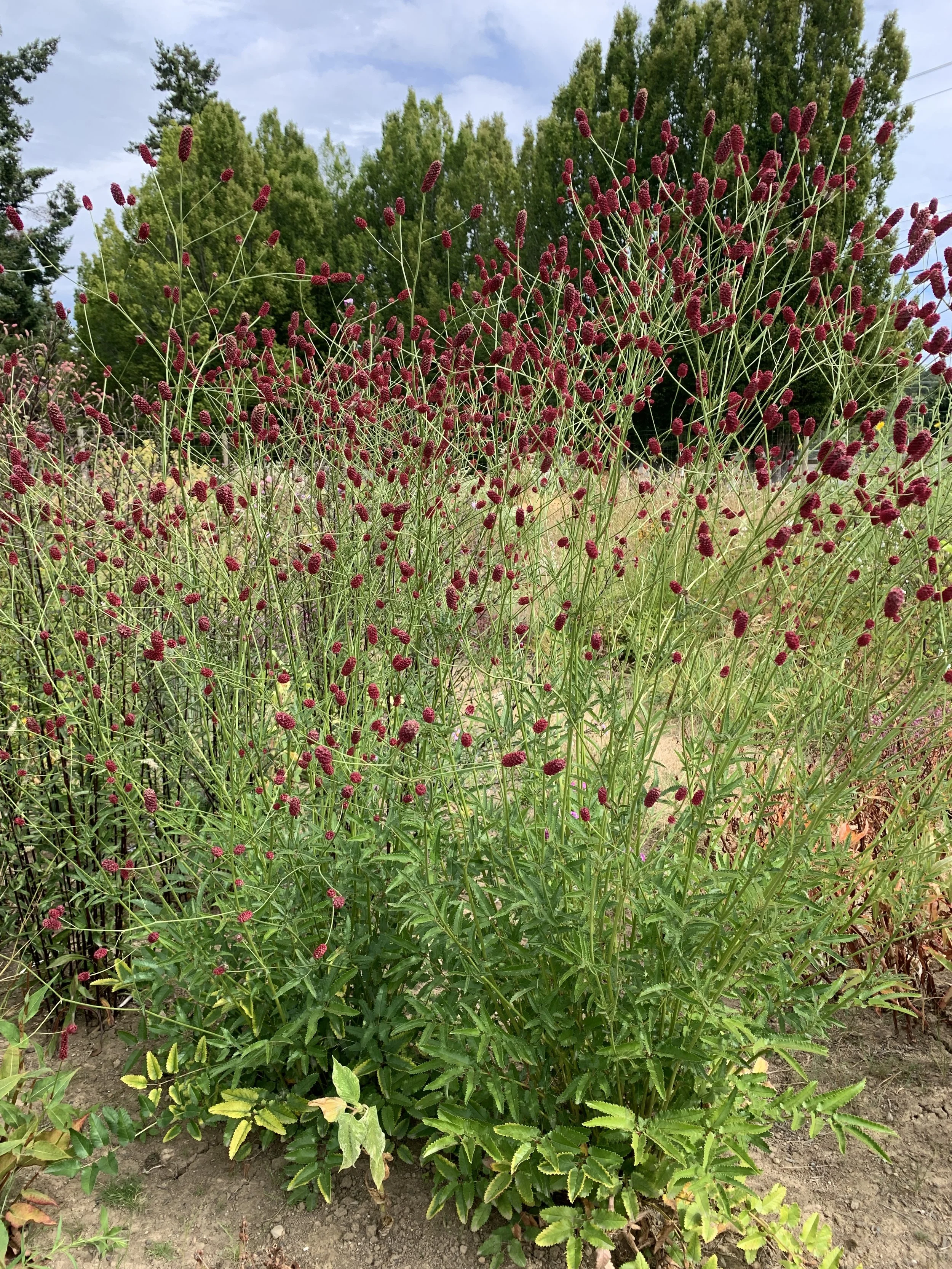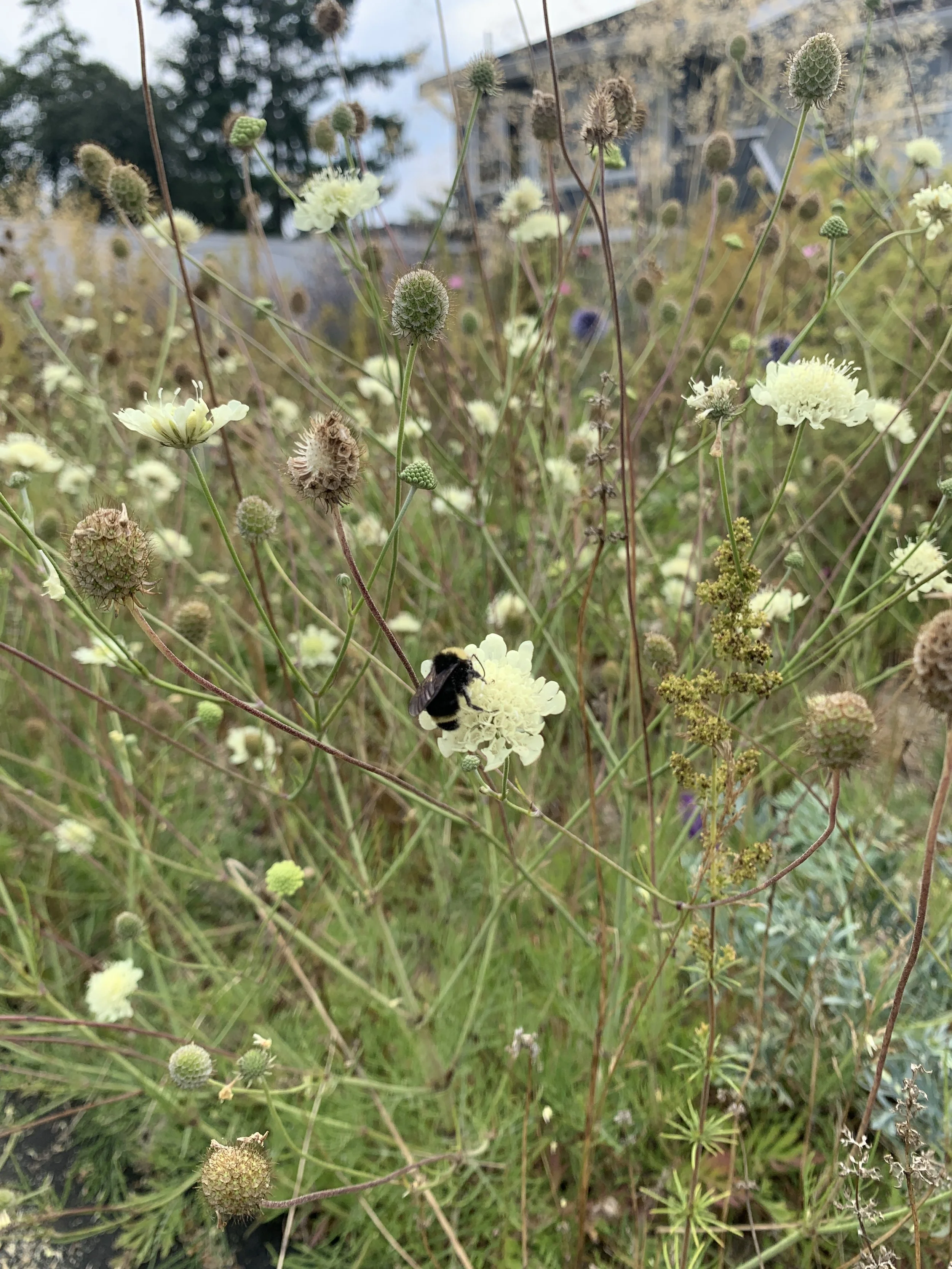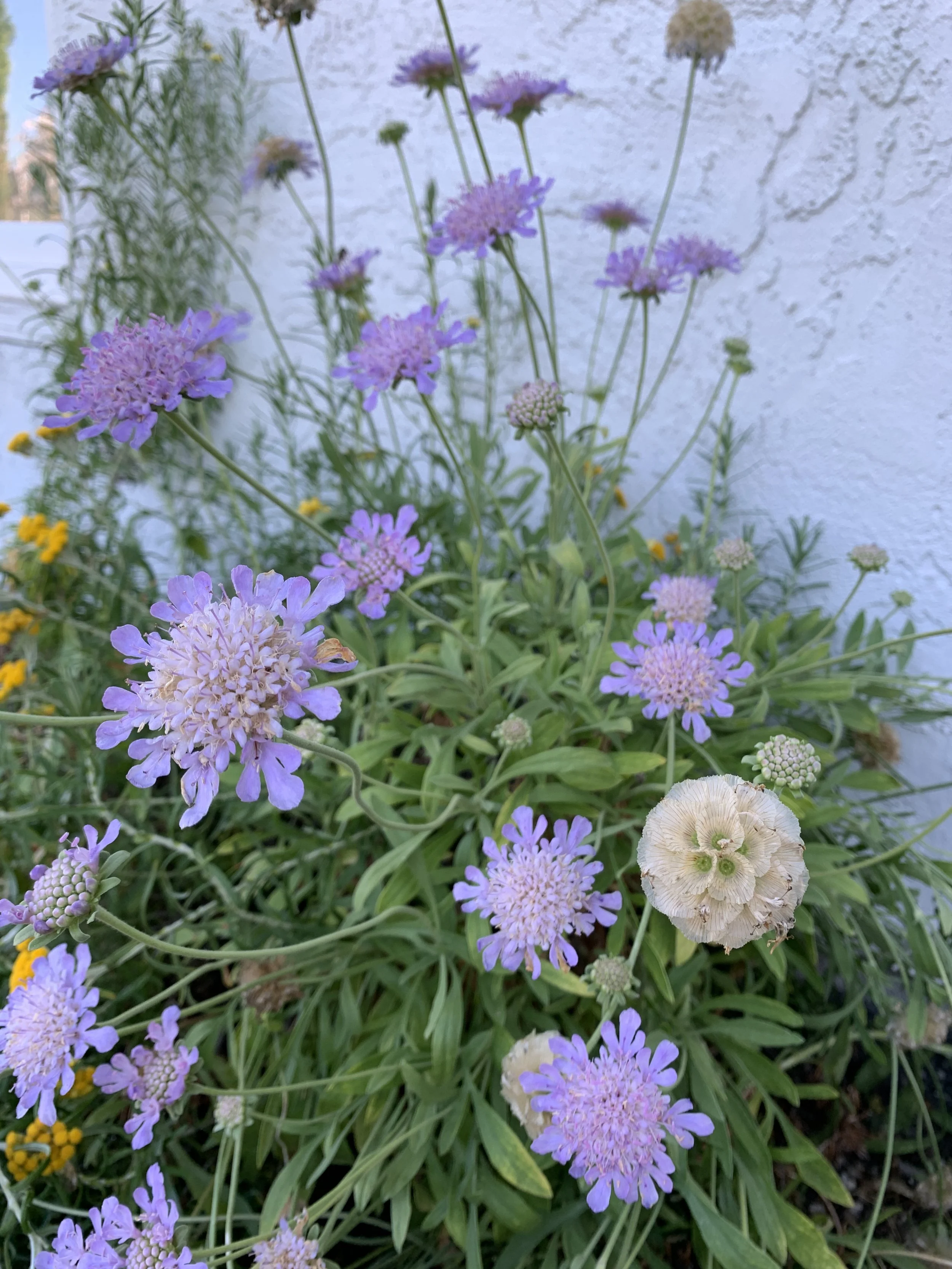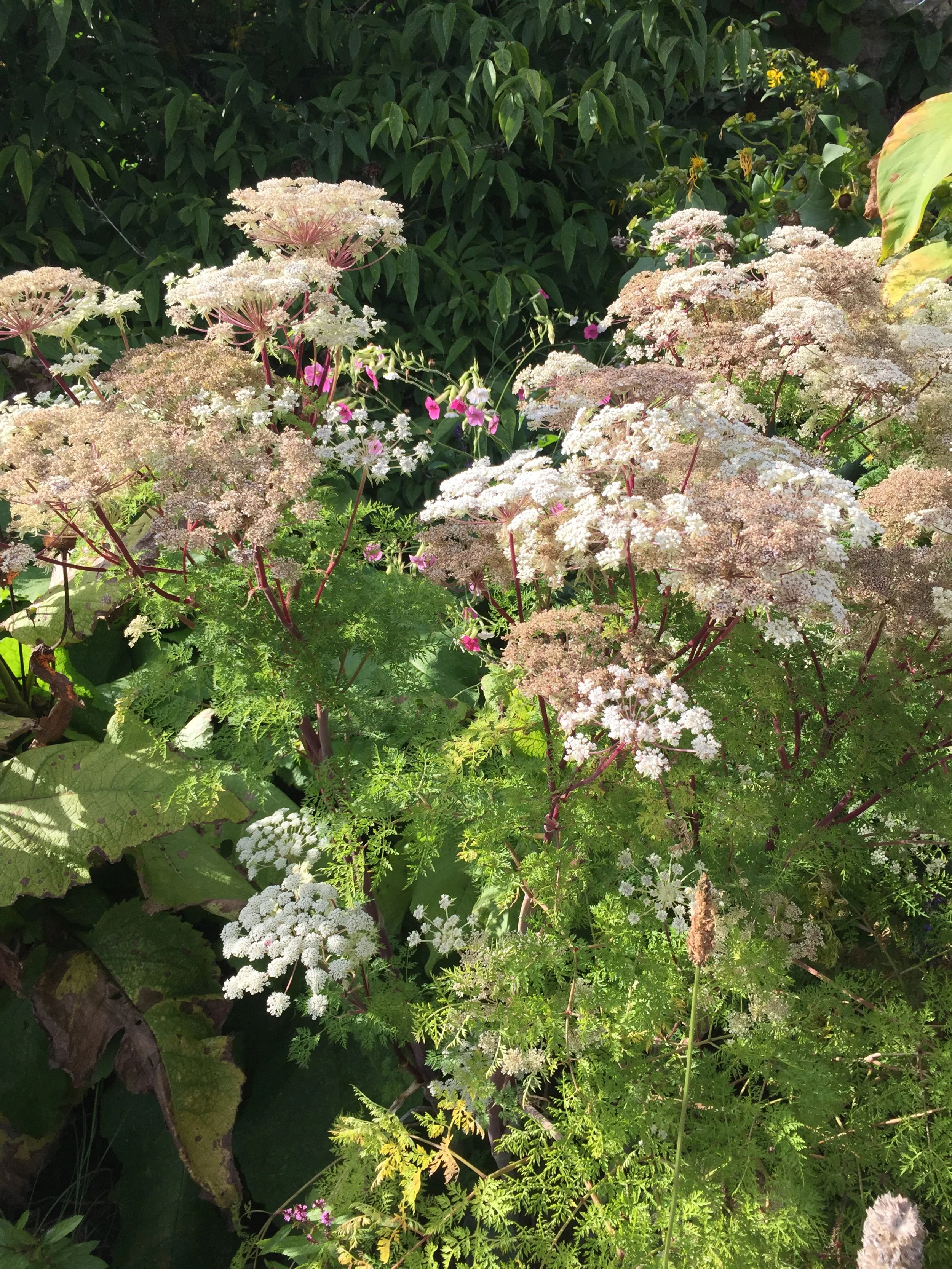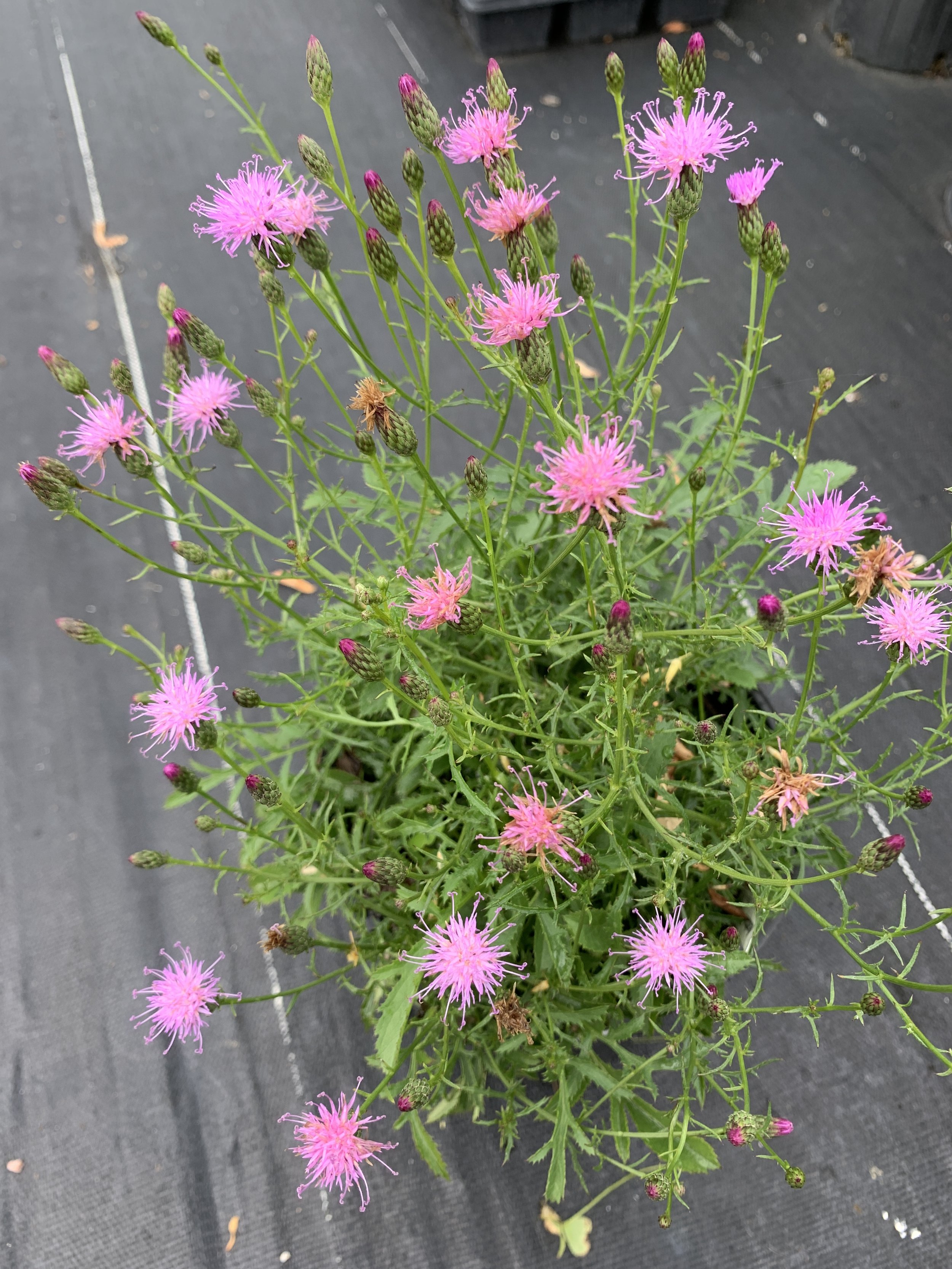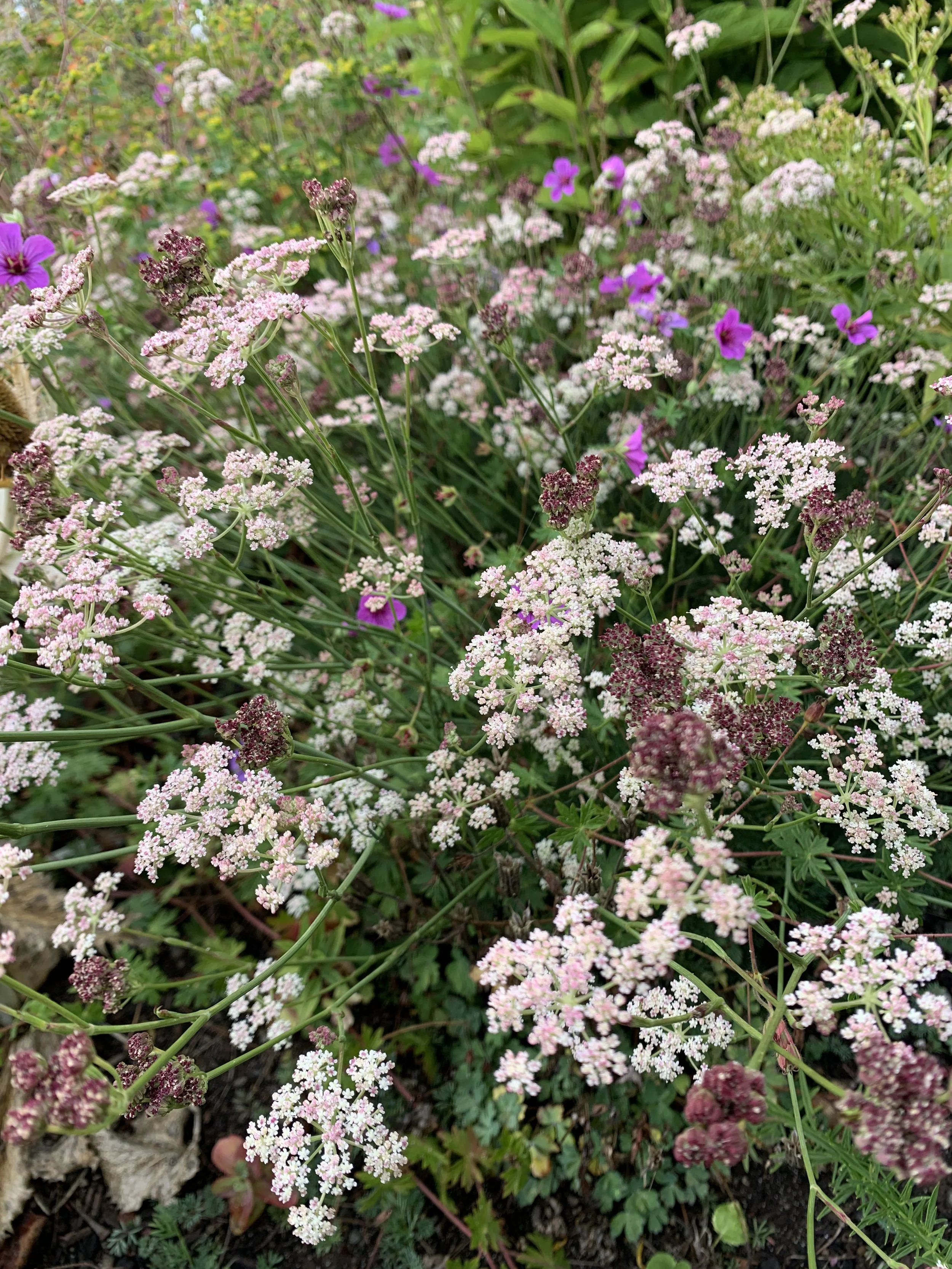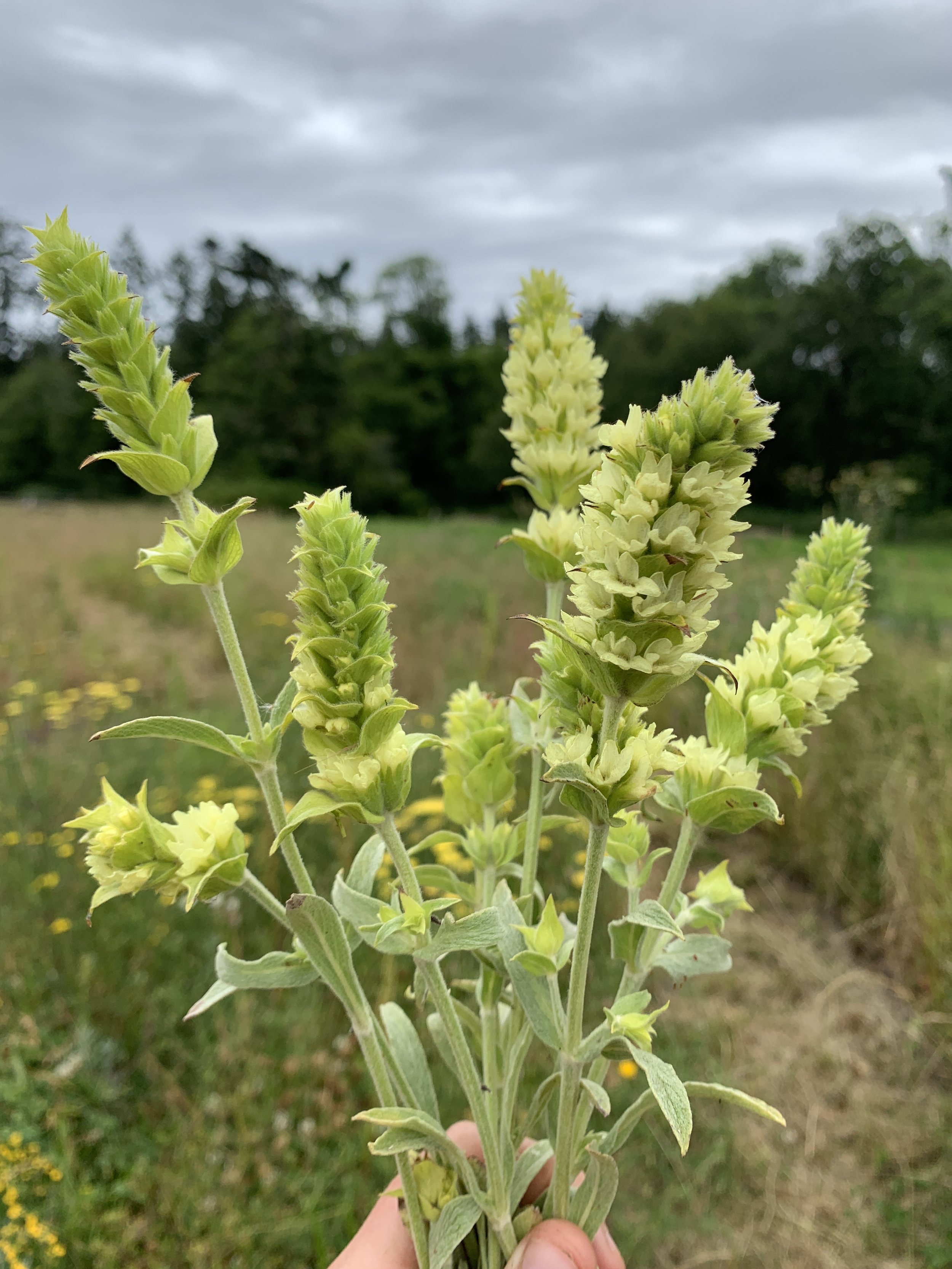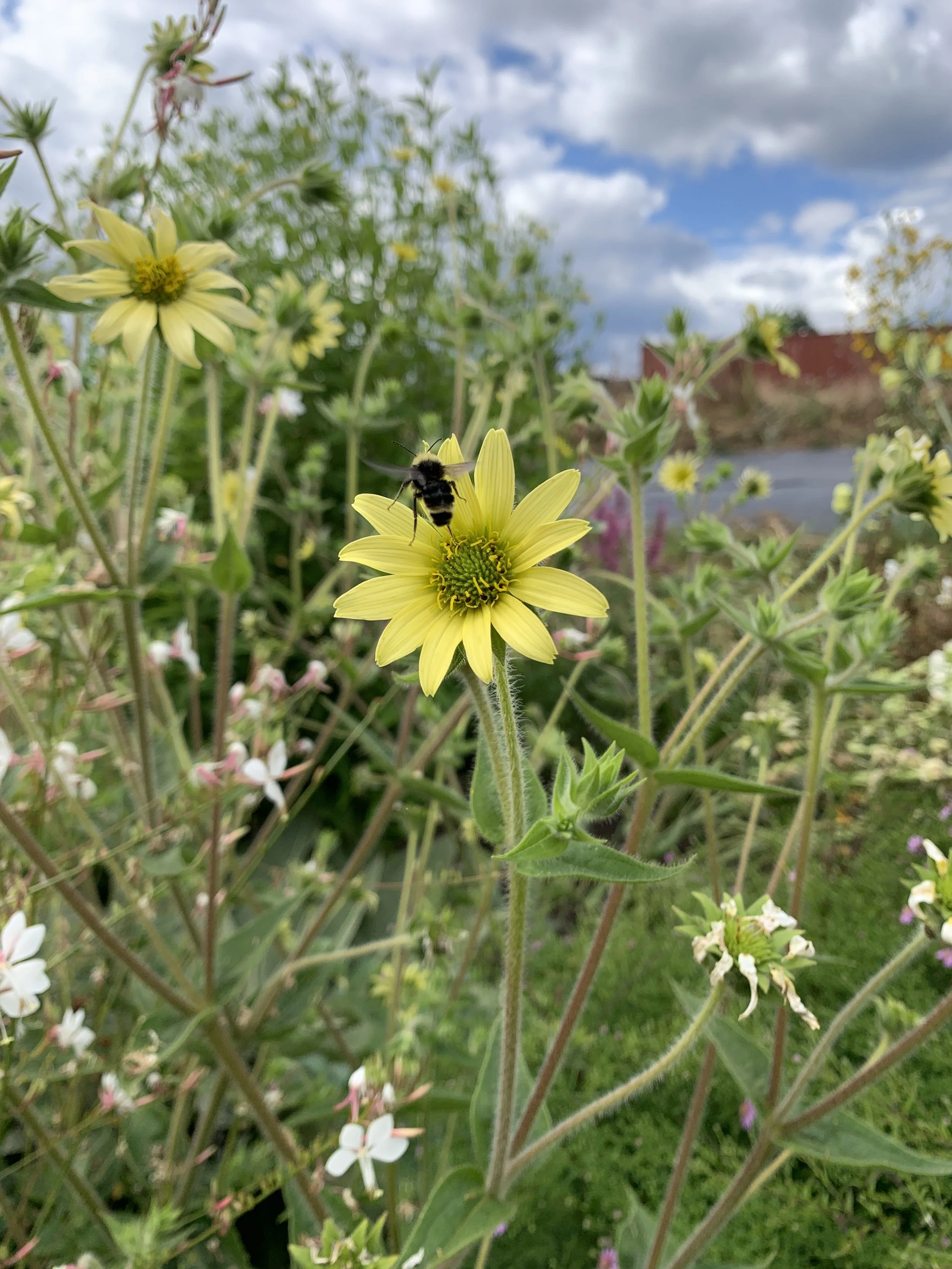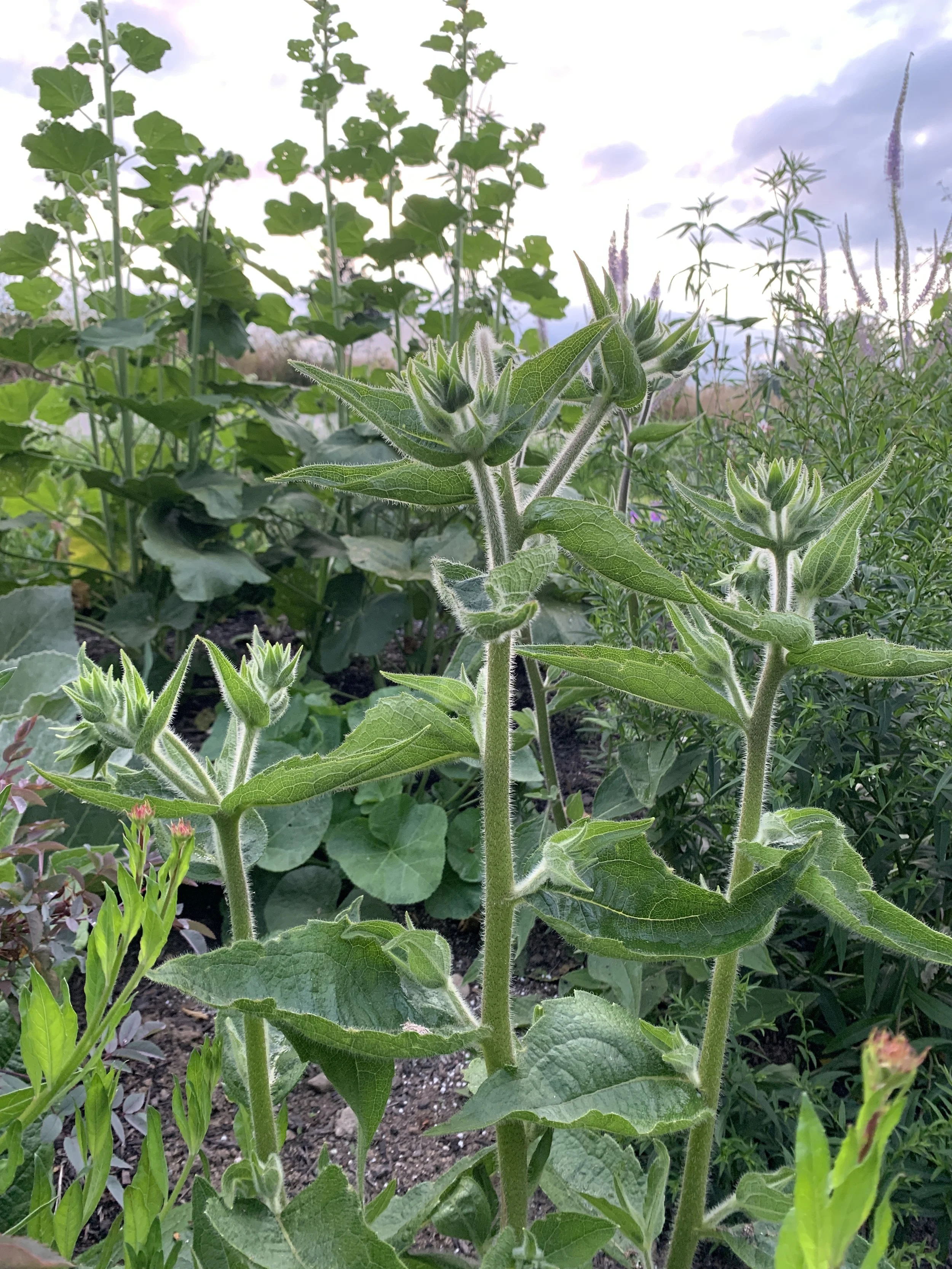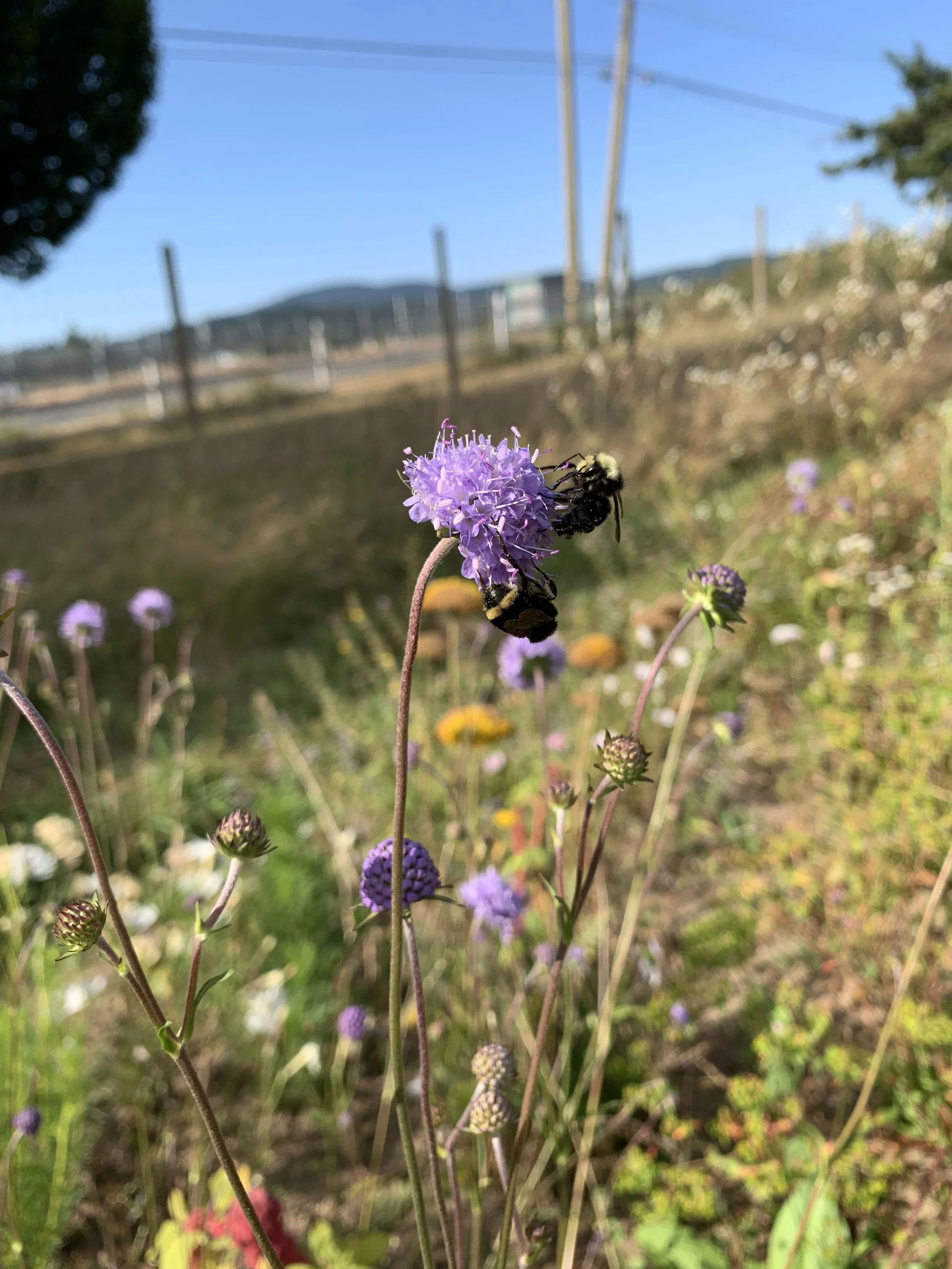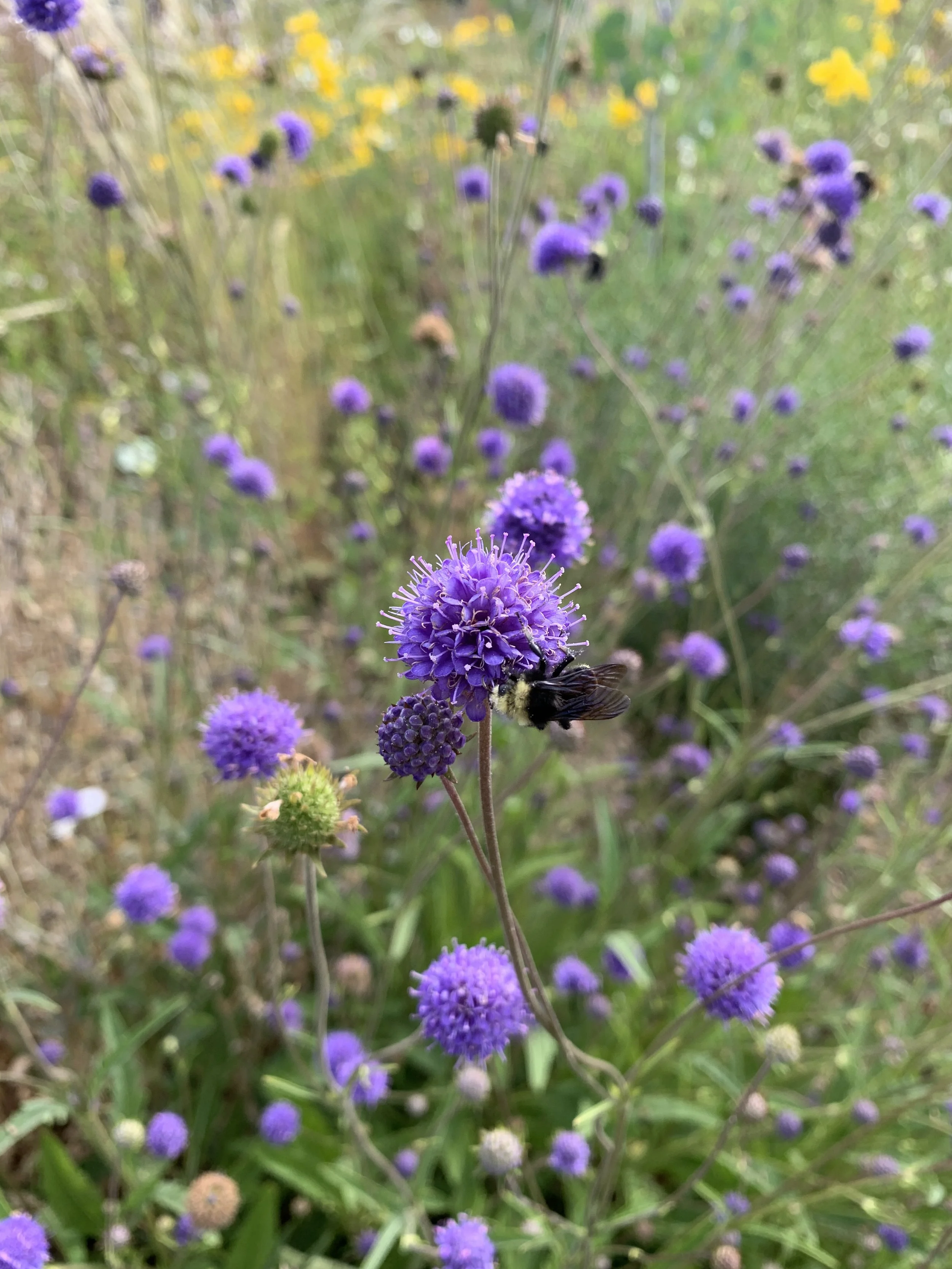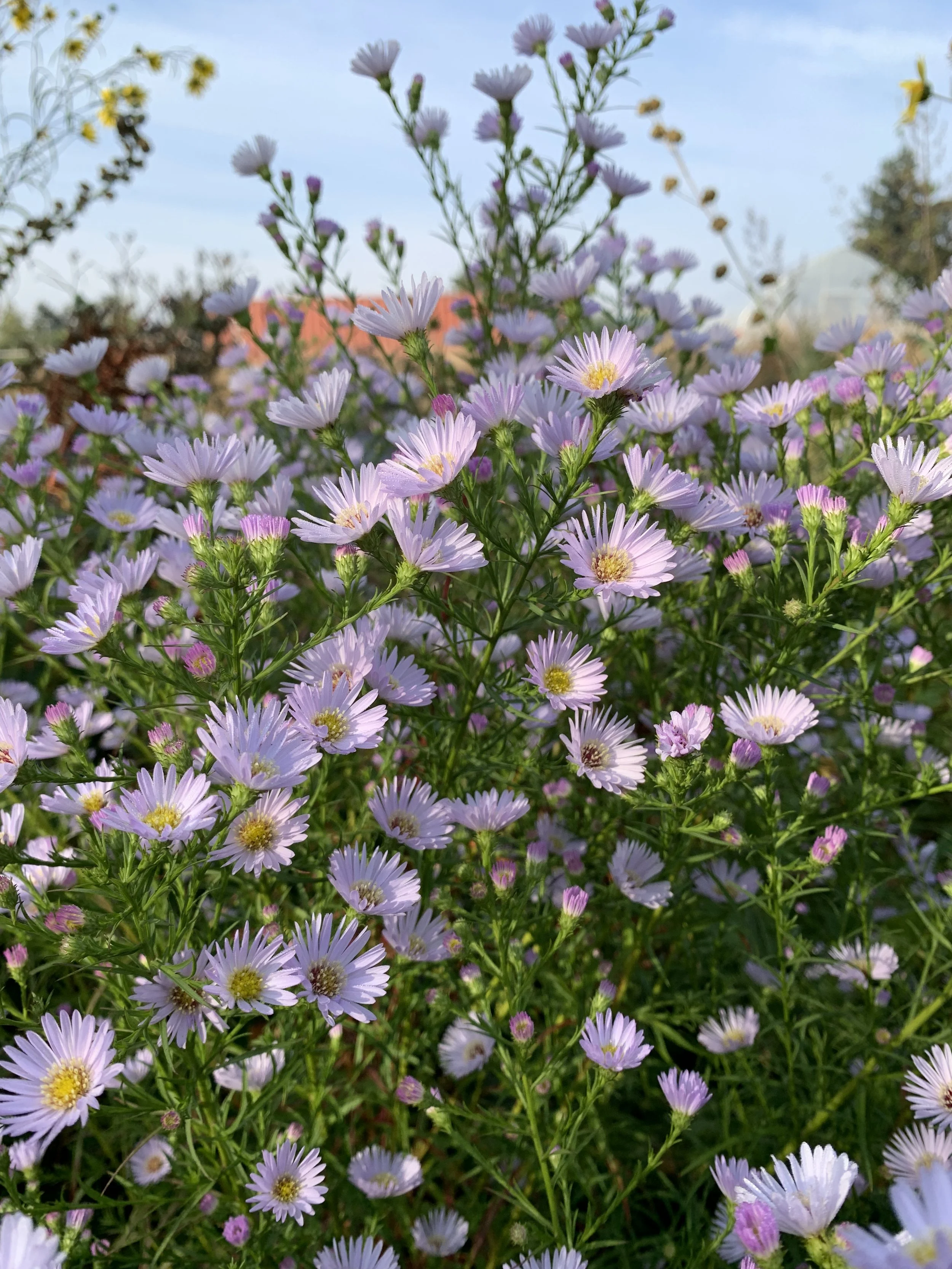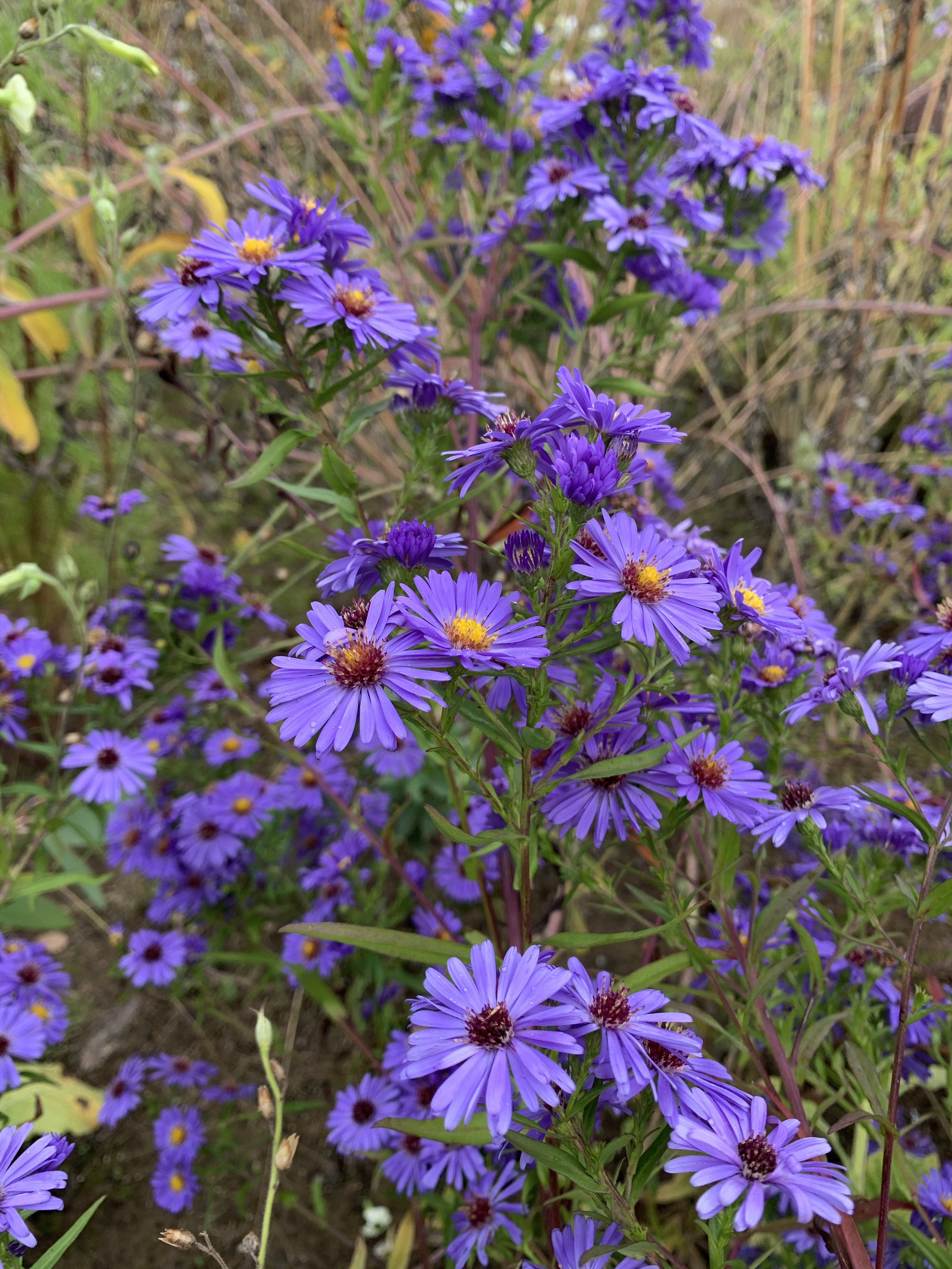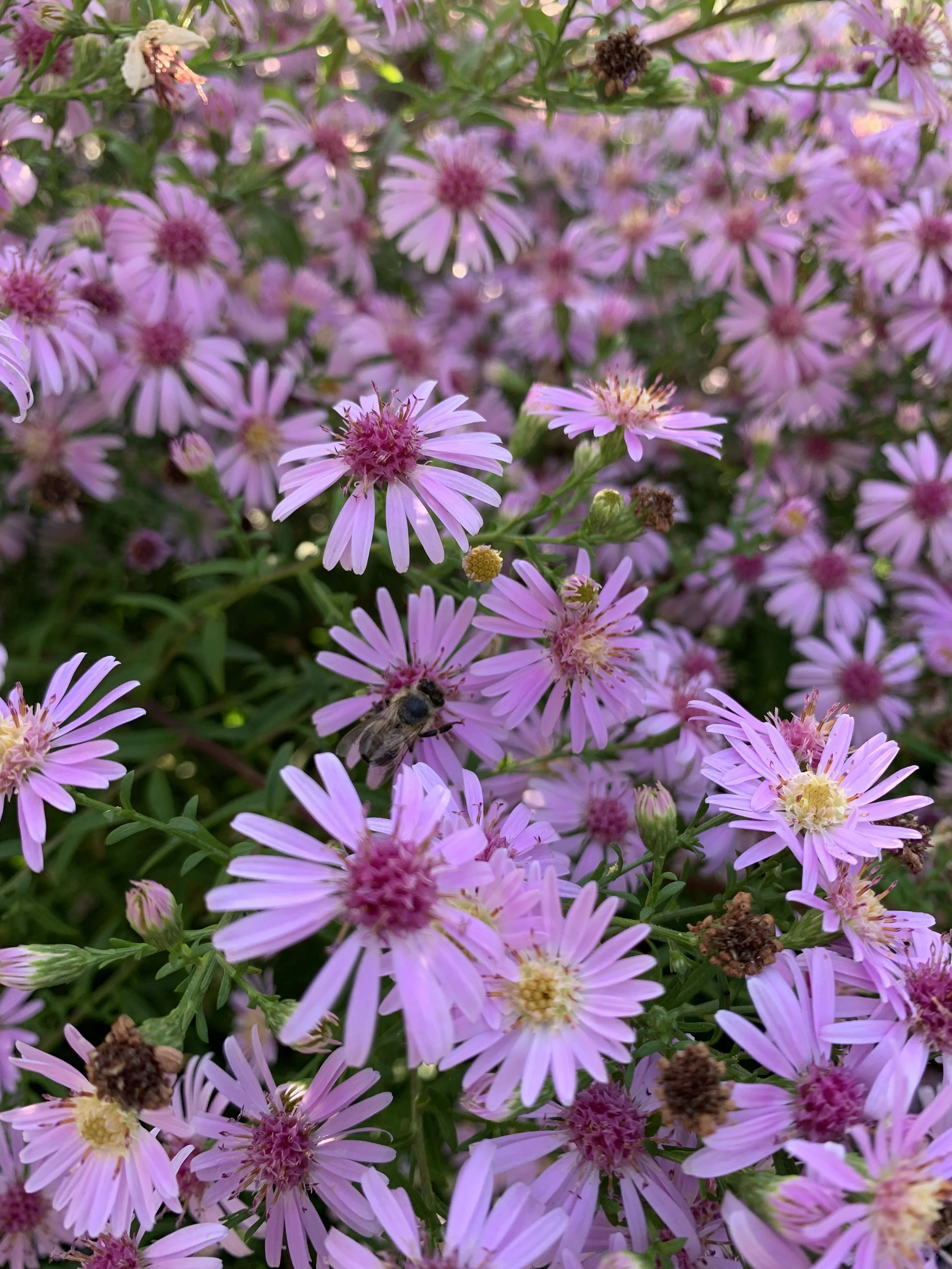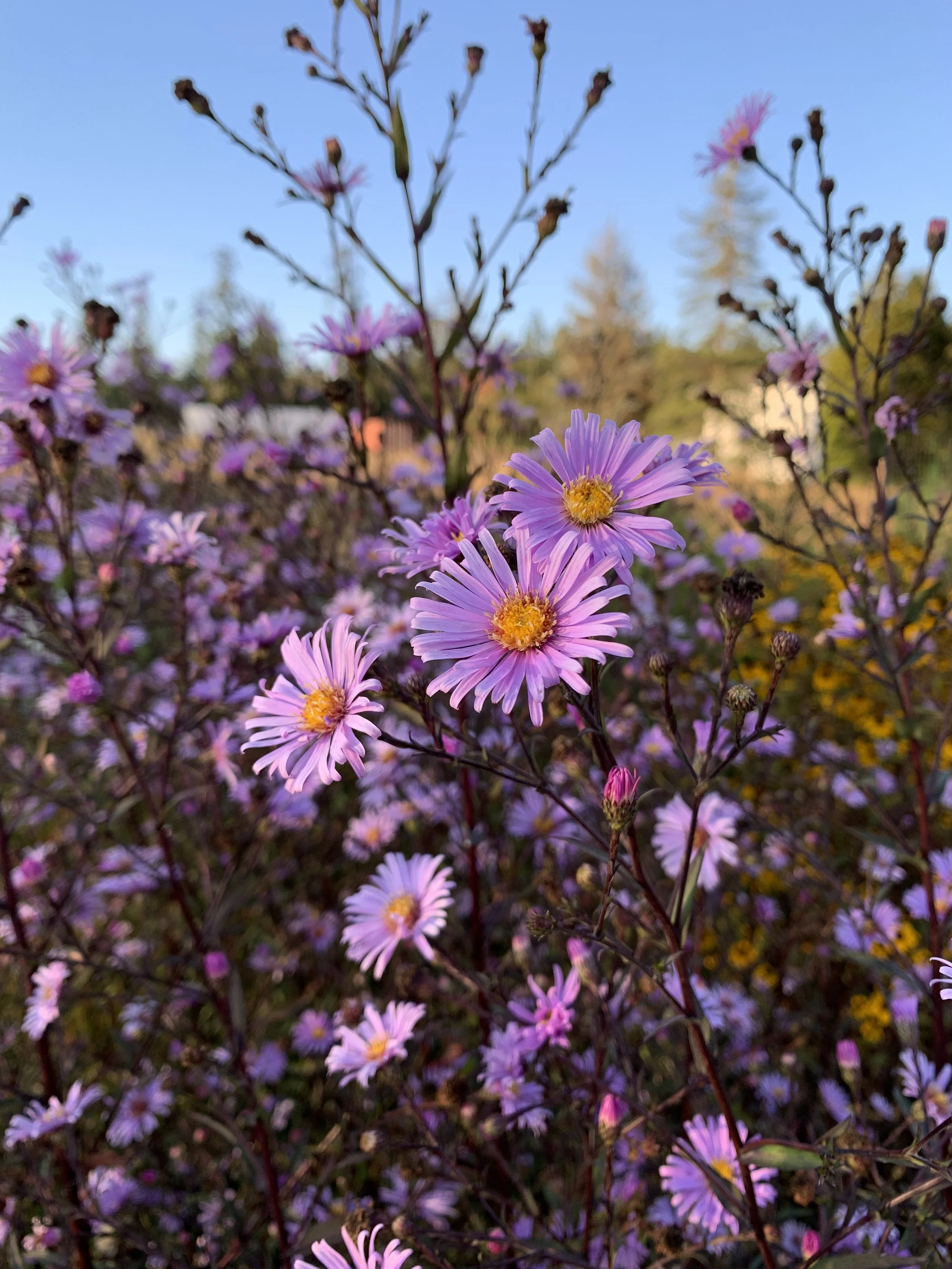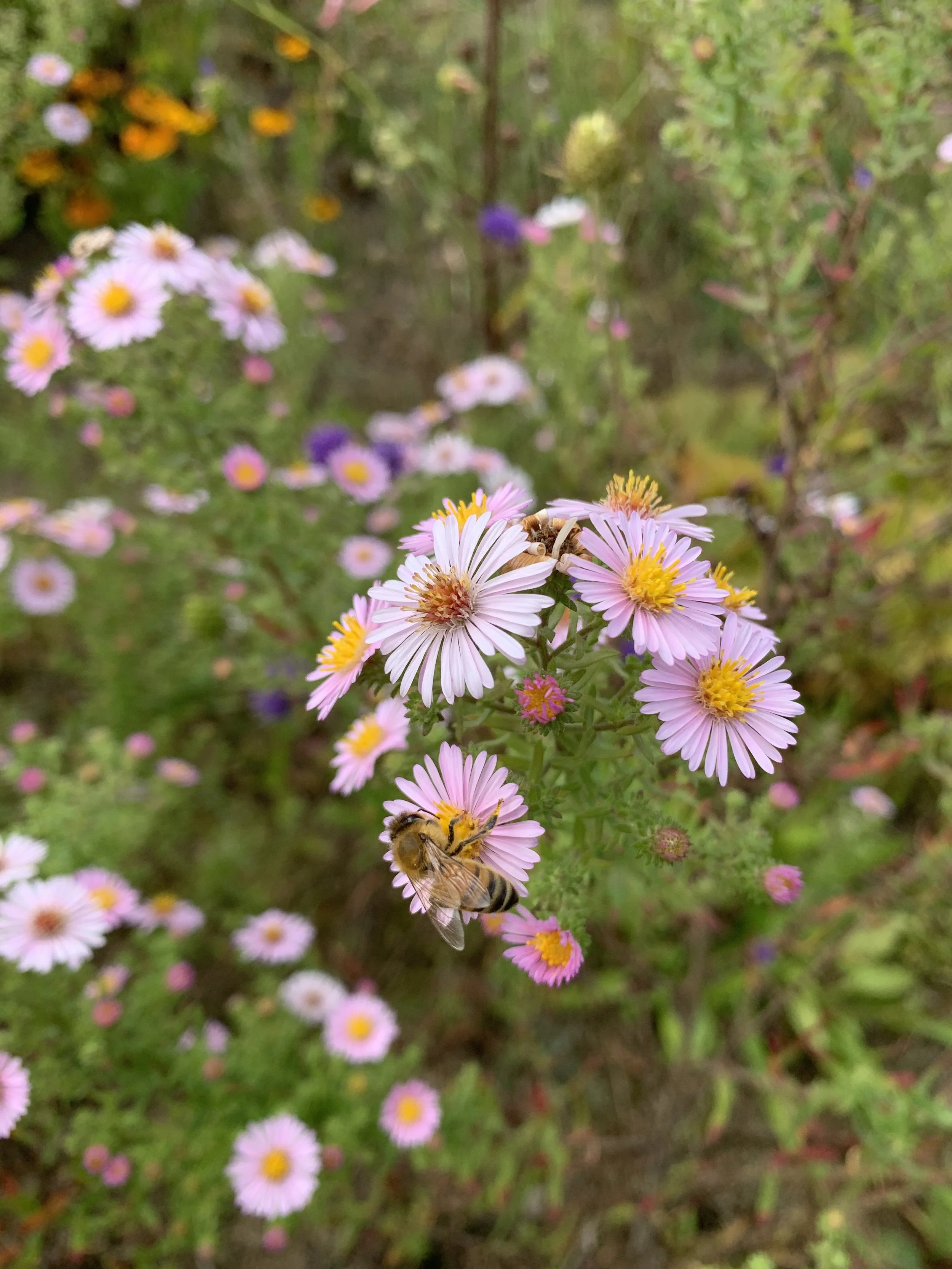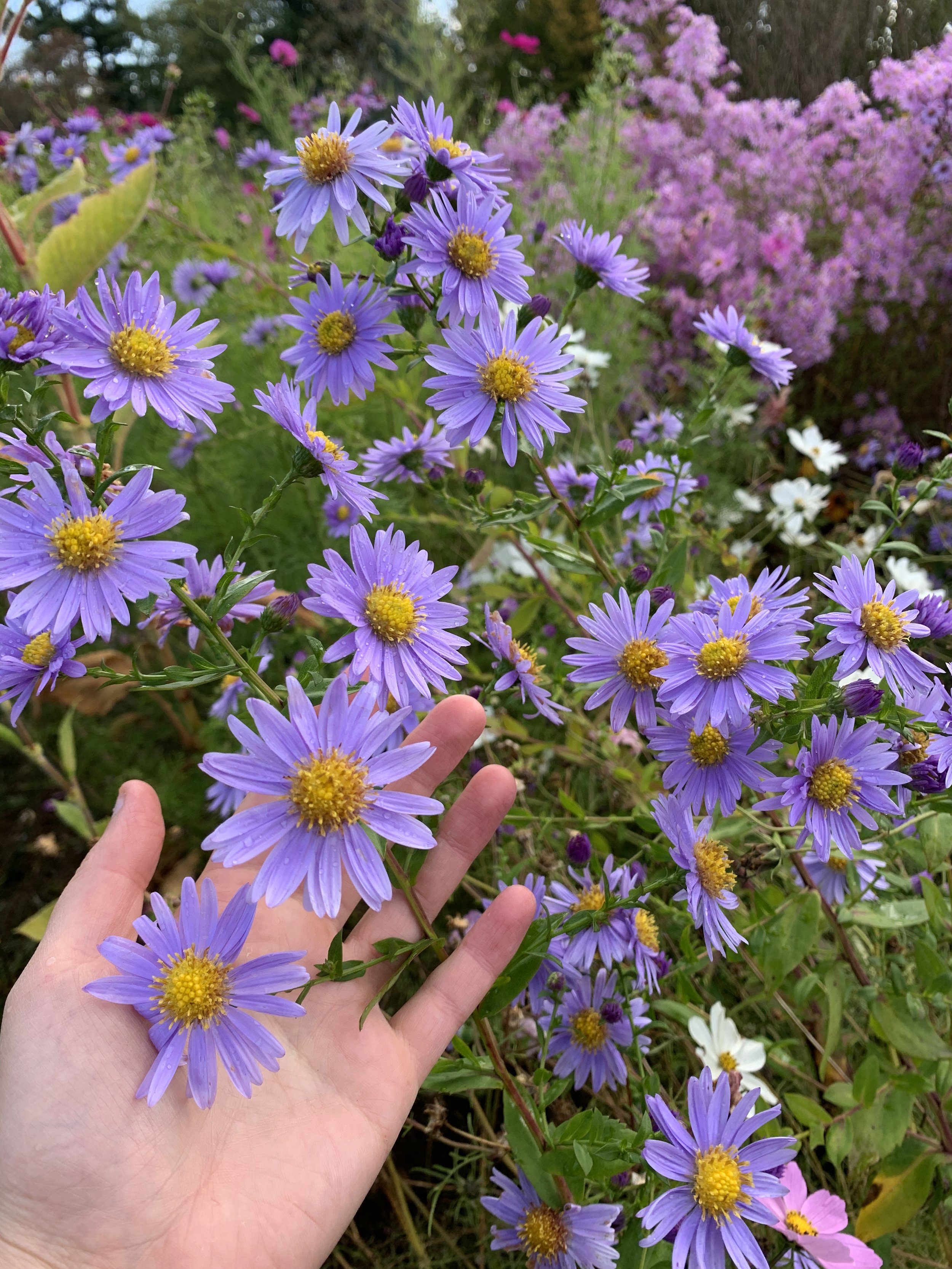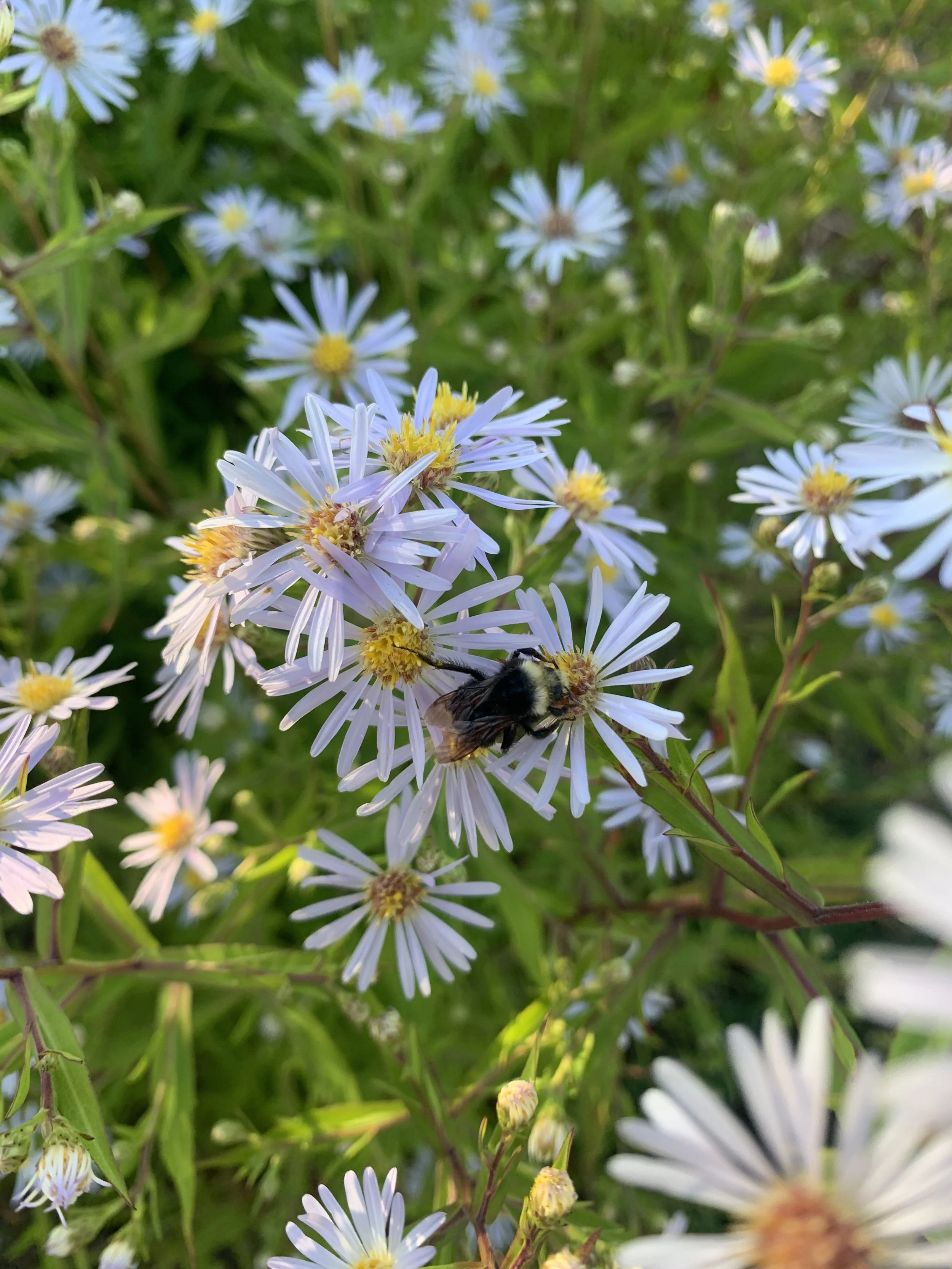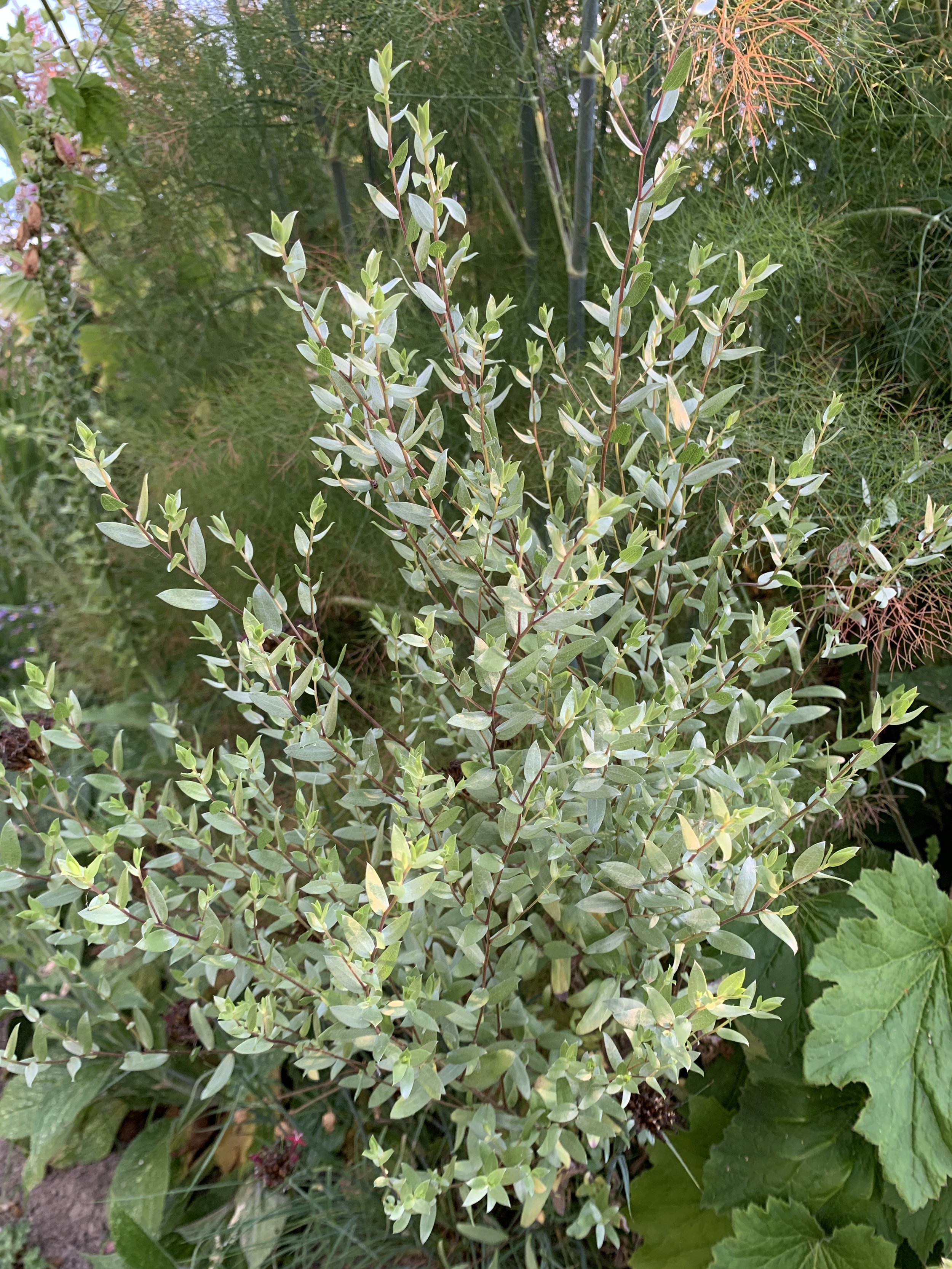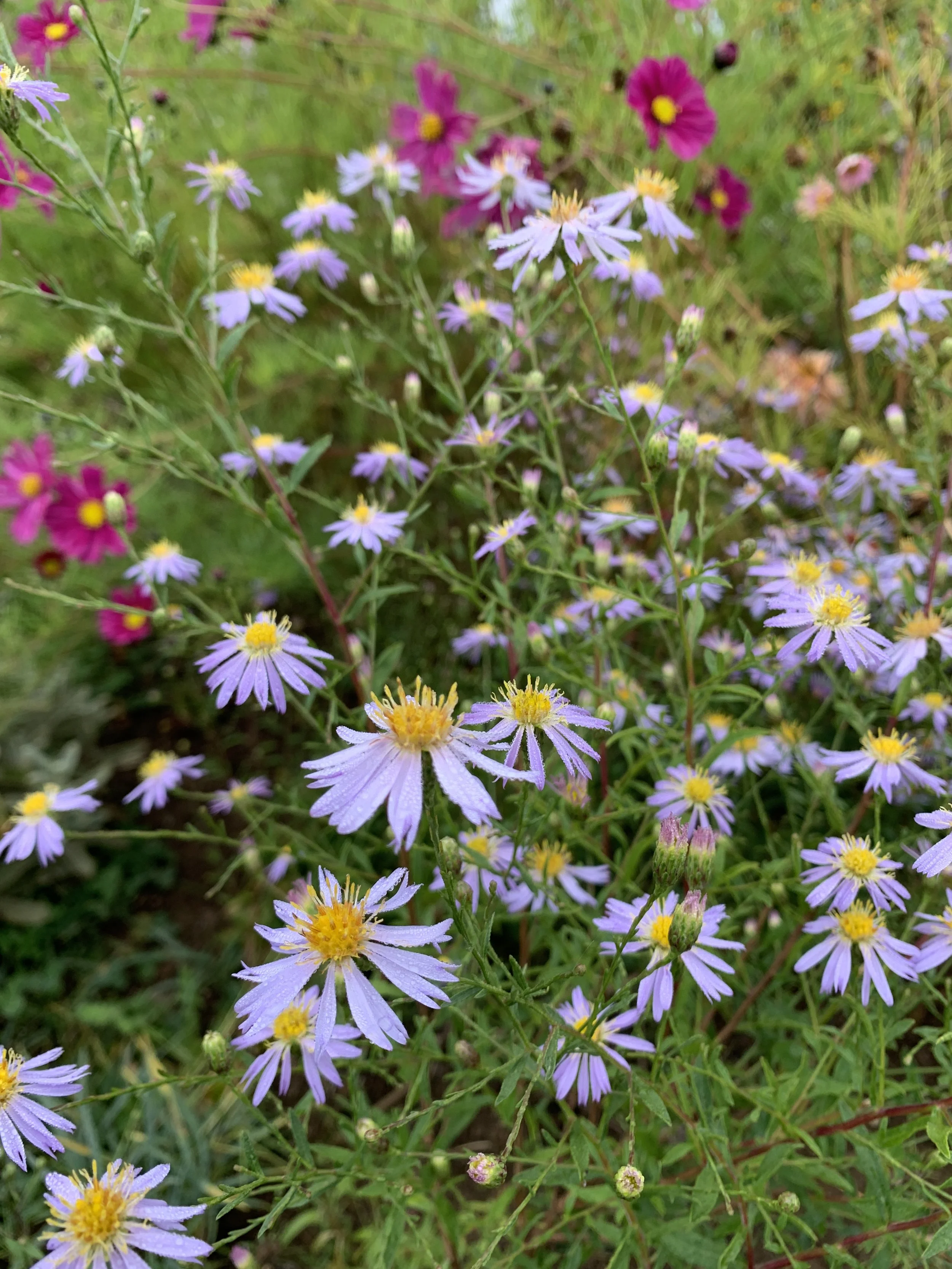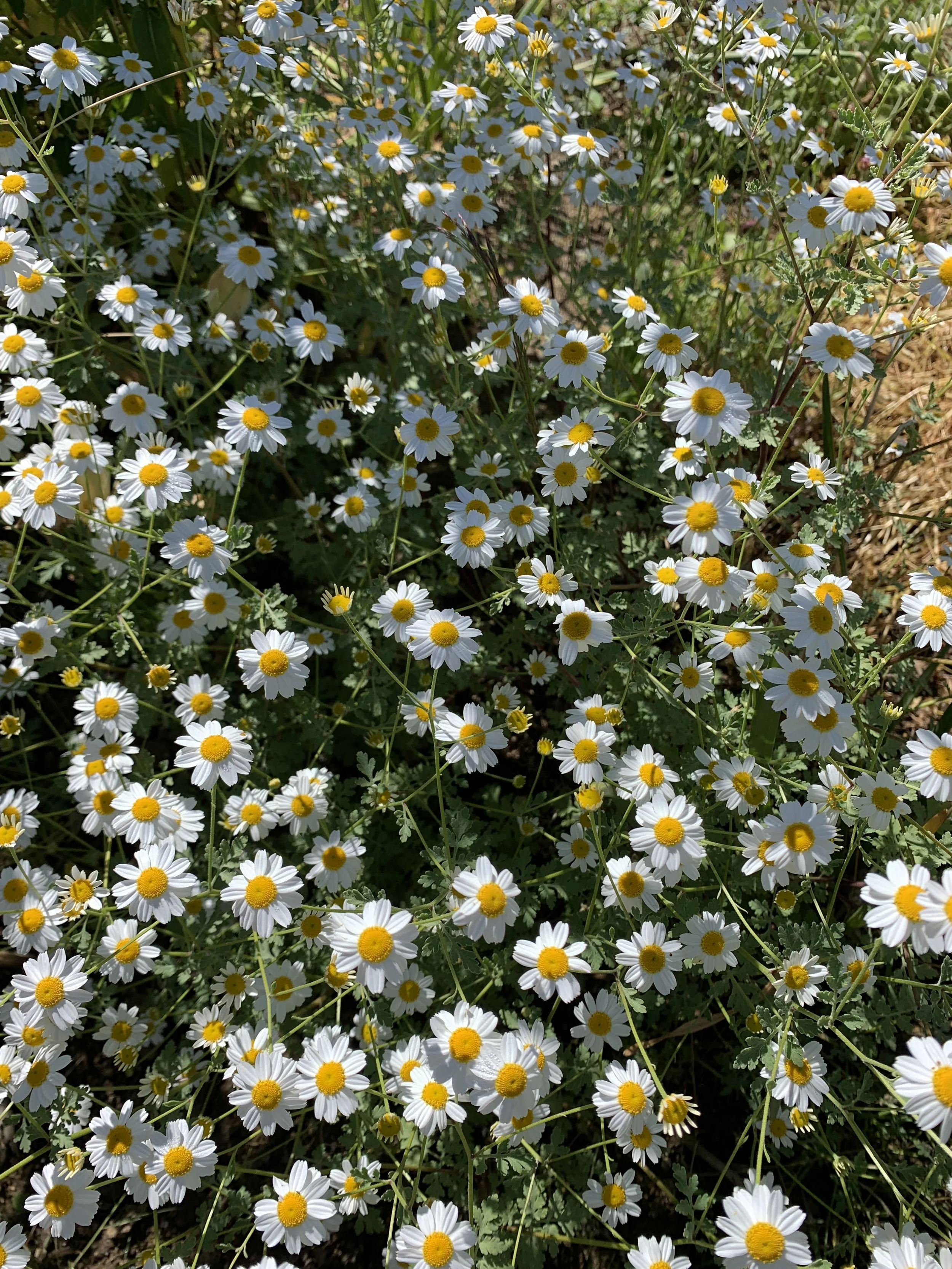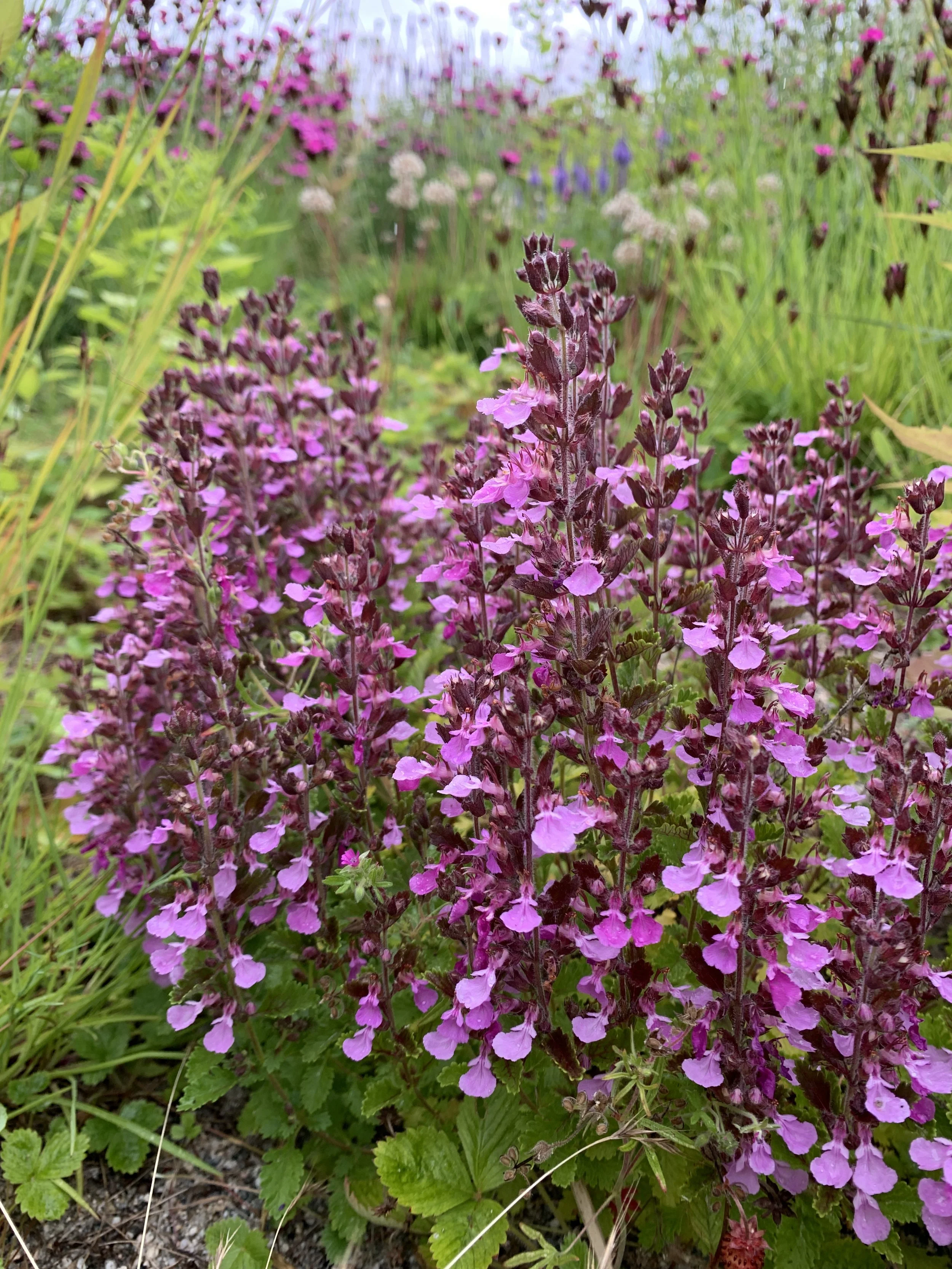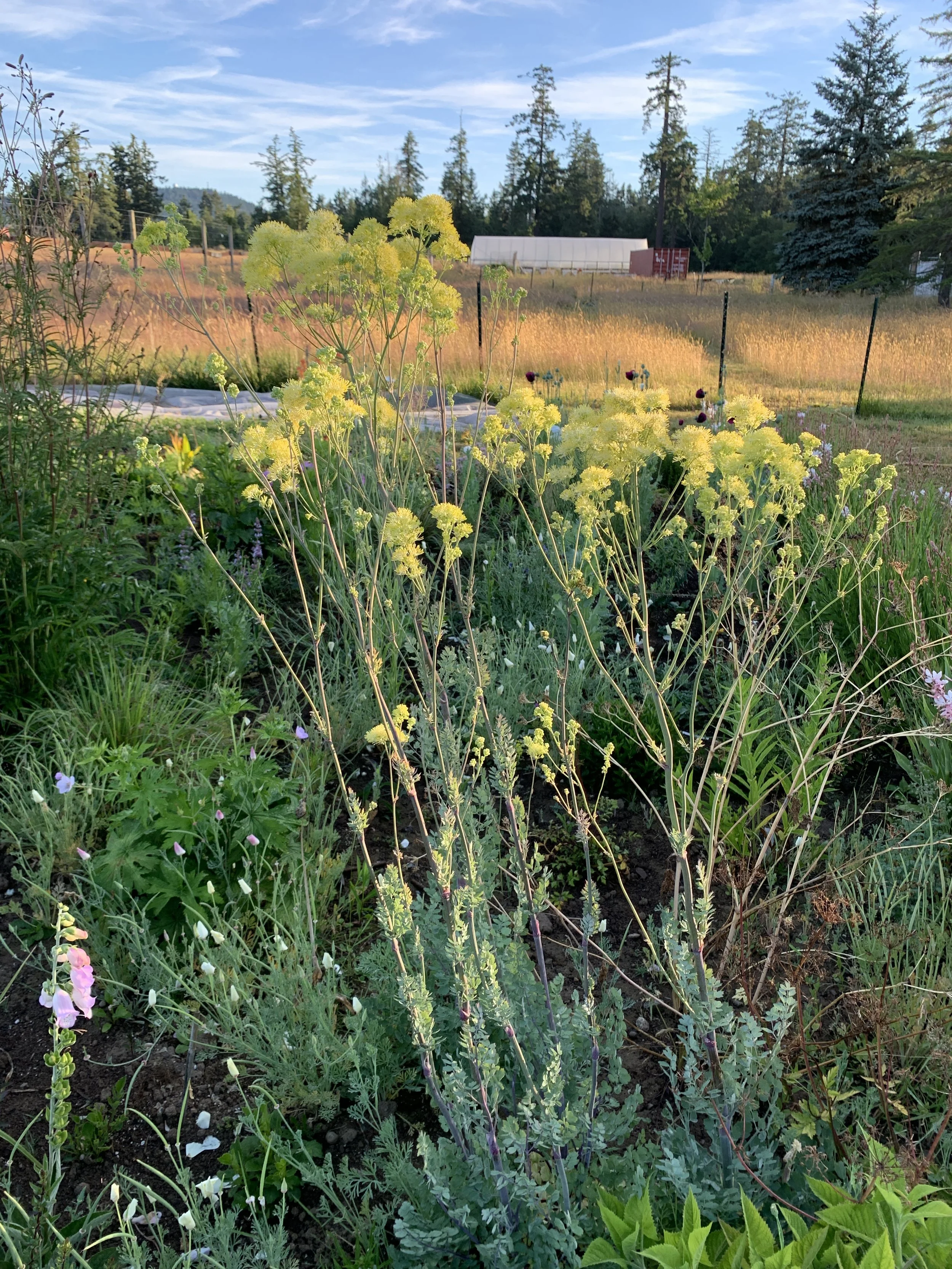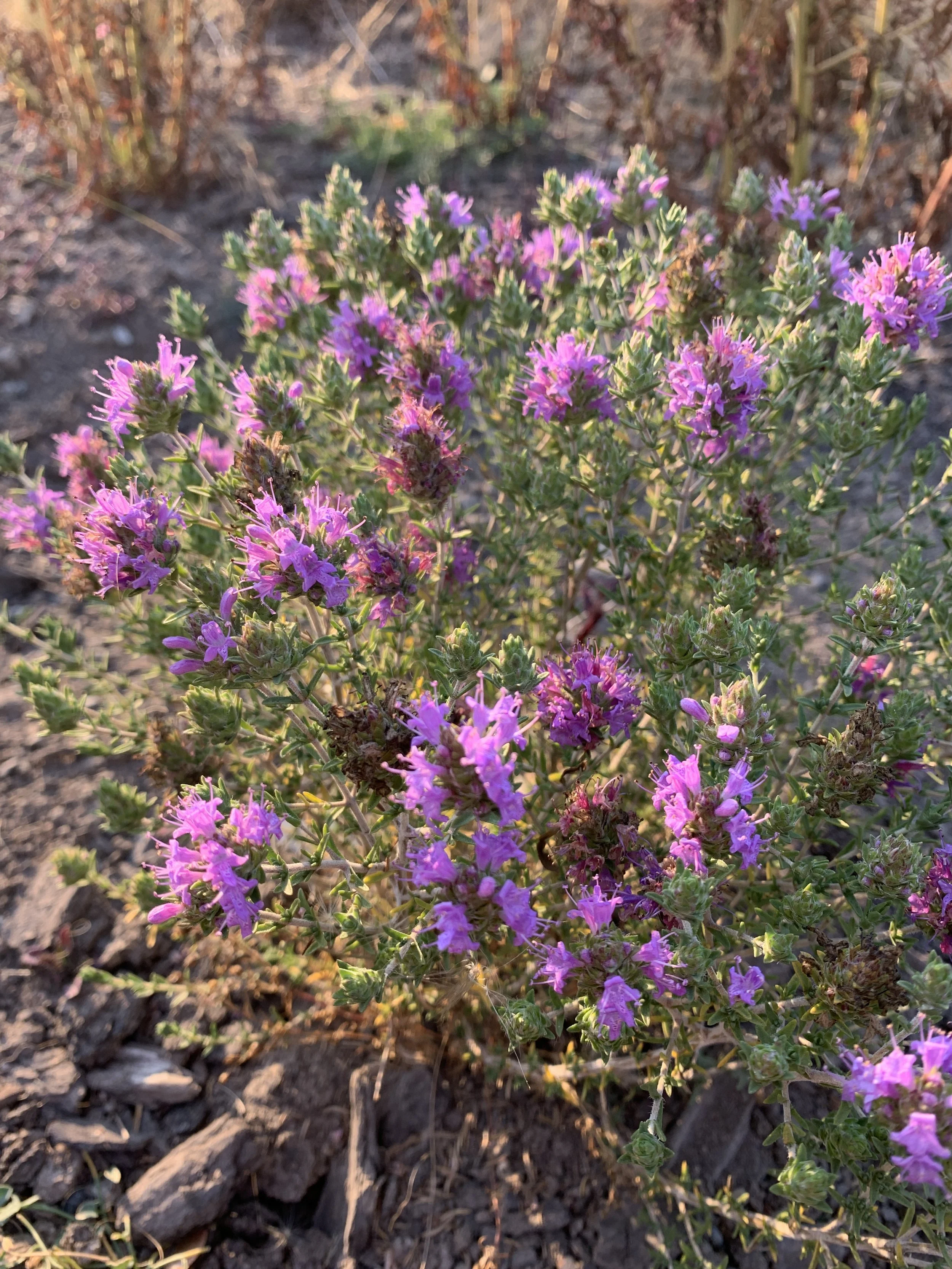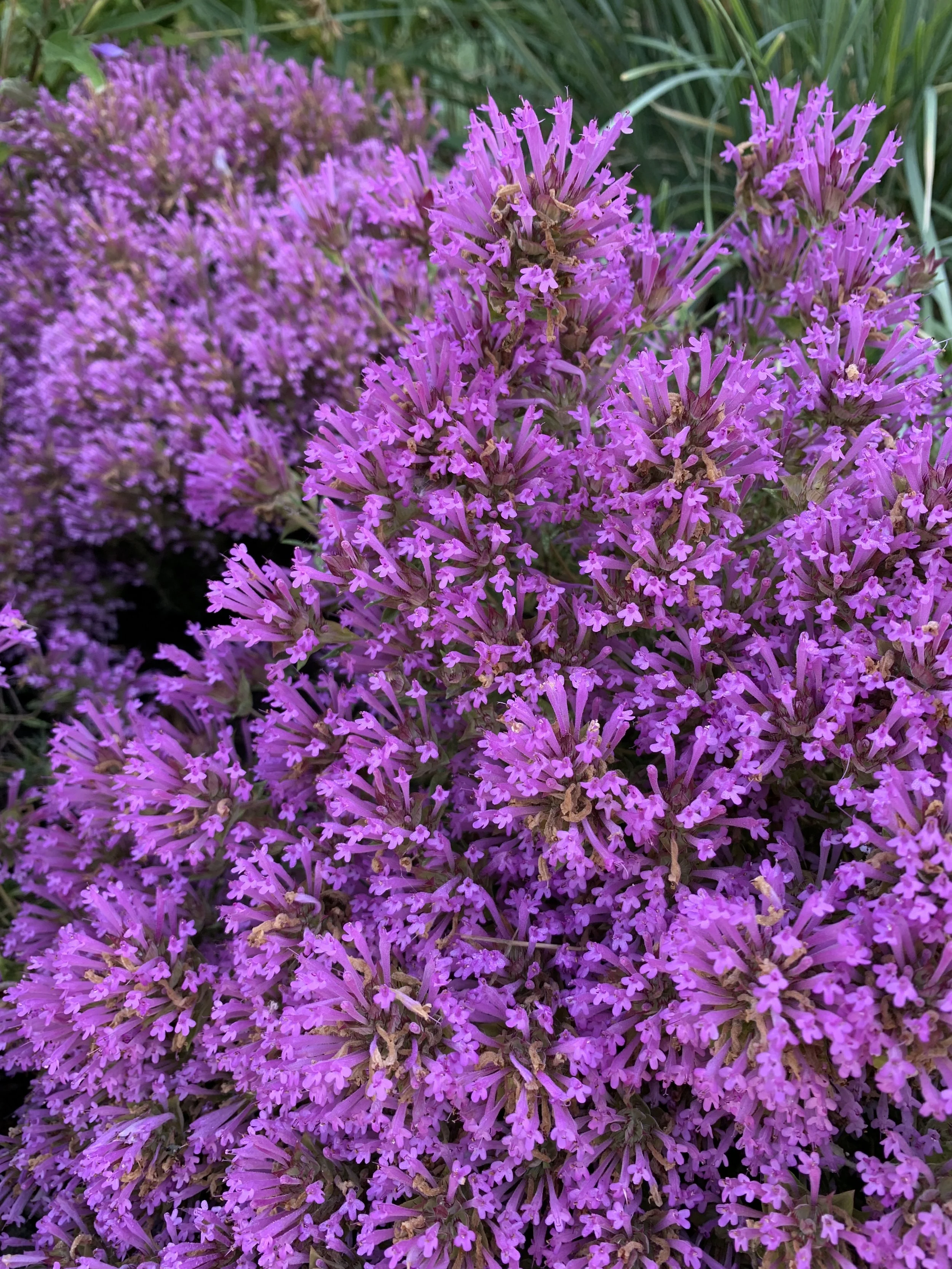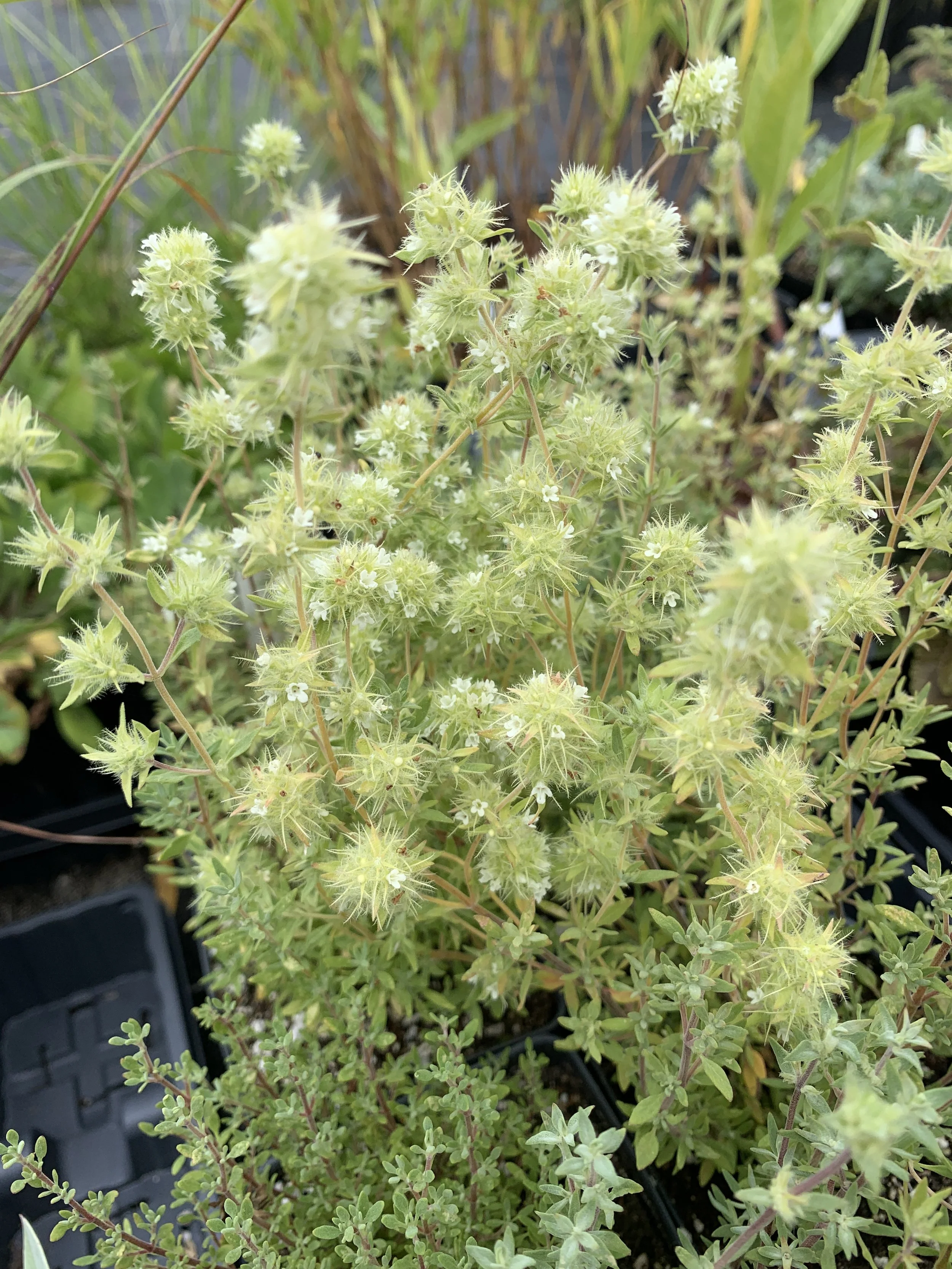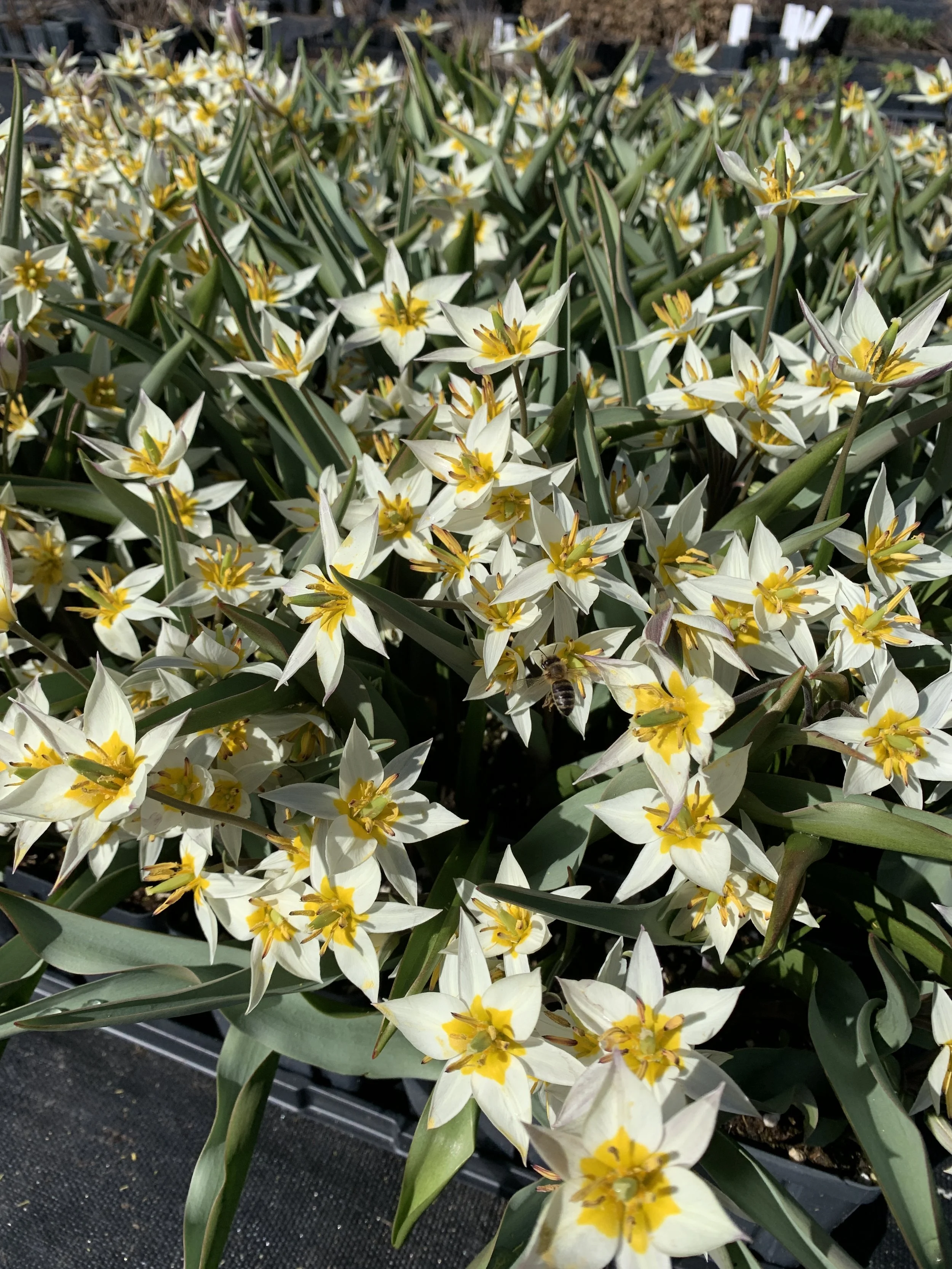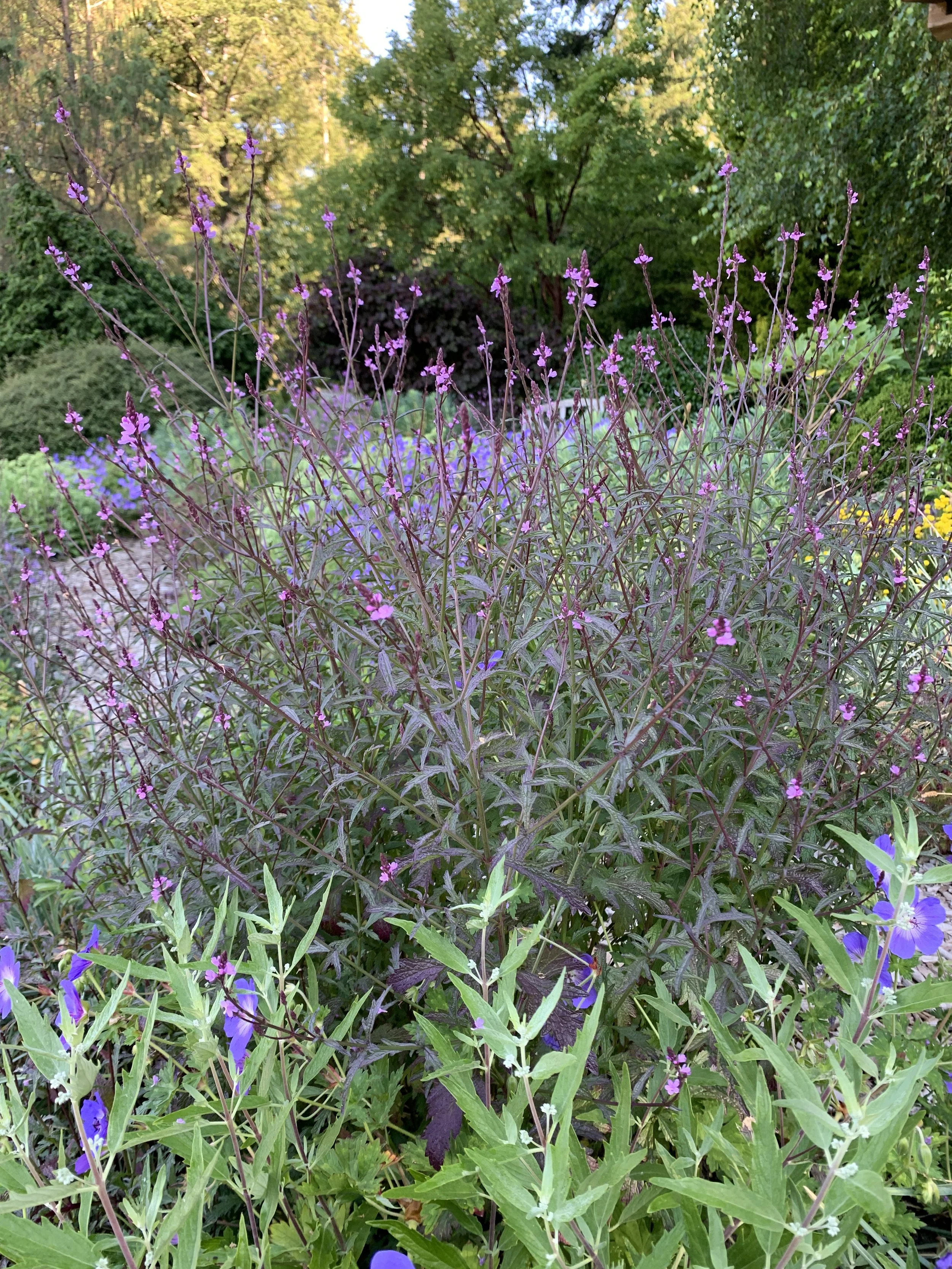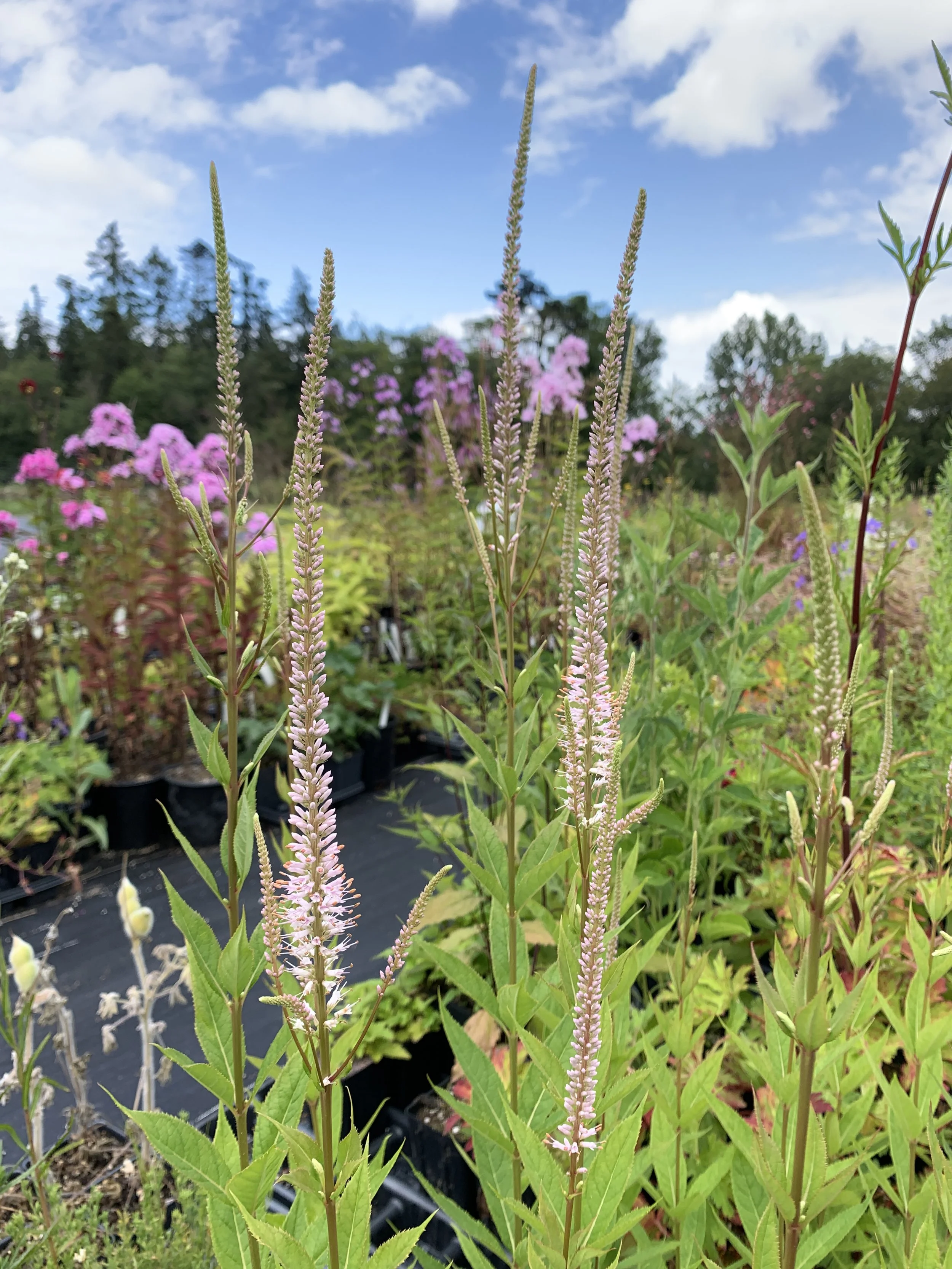Salvia lavandulifolia - Forms a low mound of evergreen silver leaves. Purple sage flowers in late spring and early summer. Very drought tolerant, more so than most S. officinalis cultivars. Sun, well-drained, drought tolerant, height 35-45 cm.
Salvia moorcroftiana x indica - A perennial sage with candelabras of lavender blue flowers emerging from a rosette of super scented, fuzzy leaves. It begins flowering in late spring and should continue well into summer with some summer water. Sun, well-drained, low water (possibly drought tolerant?), height 60-90 cm.
Salvia recognita - Pale pink flowers on branching stems appear in the second year. Relatively short-lived (a few years usually) so let it self-sow. Good planted amongst other things that can support the flowering stems. Sun, well-drained, low water, height of flowers 100-120 cm.
Salvia sclarea var. turkestanica - Clary Sage. Sometimes flowers in first year, but more typically will form a fuzzy-leaved rosette, which bursts into a giant candelabra of bloom in second year. Flowers are pale blue with white. Will self-sow in good conditions. Biennial, sun, low water, flower height to 100 cm+.
Salvia sclarea var. turkestanica ‘Vatican White’ - White-flowered Clary Sage. Sometimes flowers in first year, but more typically will form a fuzzy-leaved rosette, which bursts into bloom in second year, sending up a flowering stalk over 1 m tall. Will self-sow in good conditions. Biennial, sun, low water, height 100 cm.
Salvia taraxacifolia - Drought resistant, low growing salvia with pink flowers and fragrant, silvery leaves. Sun, well-drained, drought resistant, height to 25 cm.
Sanguisorba ‘Cangshan Cranberry’ - A tall, red sanguisorba named by Marina Christopher from seed collected by Daniel Hinkley. It blooms in August, and is usually a bit floppy by September, but we’ll forgive it for being so bold and vigorous, forming strong clumps in just a few years. Sanguisorbas all need summer water but with heavy soil they will make do in low water conditions. Can be used for cutting. Great pollinator plant. Sun, height 170cm+.
Santolina chamaecyparissus - A classic gravel garden shrub with fine silver leaves. It looks best in hot, lean soil where it will form a tight mound. Yellow button flowers that can be removed after blooming for best effect. Sun, well-drained, drought tolerant, height 20-40 cm, spread 40-80 cm.
Santolina rosmarinifolia - A green, mounding shrub with fine leaves and yellow button flowers. It looks best in lean soil. Sun, well-drained, drought tolerant, height 40-50 cm, spread 40-80 cm.
Satureja montana ssp. illyrica - This winter savory can take drought or irrigation and is fully hardy here. Pollinators are big fans! Flowers better with a little summer water. Sun, well-drained, drought tolerant, height 15 cm.
Satureja thymbra - Very cute! Will eventually form an attractive cushion of scented, evergreen leaves. Sun, well-drained, drought tolerant, height 30 cm+.
Scabiosa atropurpurea 'Black Knight' - Scabiosa make beautiful cut flowers, but I also like to weave them through the garden. They have pretty low water needs and if they survive the winter they produce even better. Flowers are a burgundy verging on black. Deadhead frequently. Annual to short-lived perennial. Sun, low water, height 75 cm+.
Scabiosa atropurpurea 'Snow Maiden' - Scabiosa make beautiful cut flowers, but I also like to weave them through the garden. They have pretty low water needs and if they survive the winter they produce even better. Flowers are white to cream coloured. Annual to short-lived perennials. Sun, low water, height 75 cm+.
Scabiosa columbaria ssp. ochroleuca - Flowers from mid-summer onwards in palest yellow. A very sweet addition to the dry garden, meadow, or front of border. Seems somewhat short lived, or perhaps is just fussy about drainage. But will self-sow so not to worry! First year rosette tends to have rounded leaves, whereas a flowering age plant gets more dissected leaves. Same dull green and slightly furred texture however so should be easy to identify. Sun, well-drained, drought tolerant, height 80 cm.
Scabiosa columbaria ssp. ochroleuca ‘Moon Dance’ - A shorter form with the same creamy scabious flowers. Very popular with pollinators. Drought tolerant. Short lived but will self-sow. Note that the juvenile foliage (rosette of rounded leaves) looks different than the lacy flowering-sized foliage. Sun, well-drained, drought tolerant, height 40 cm.
Scabiosa cretica - A beautiful shrub with silky, evergreen leaves. Blue flowers from spring well into summer, especially if it gets a bit of water. The papery seed heads are just as lovely. In times of extreme drought stress, S. cretica will temporarily lose foliage. Tolerates sea spray and just about any soil. Only issue is cold hardiness. No problem with freezing, but if it’s dropping to -10C or lower you may lose it unless it’s against the house or protected from freezing winds. Sun, well-drained, height 60 cm.
Selinum wallichianum - Large creamy white umbels from feathery foliage and dark stems. Needs relatively moist conditions to perform, but is a garden-worthy, long-lived perennial. Sun to part shade, height to 1.2 m.
Serratula seoanei - Adorable little purpley-pink thistle flowers in early autumn that makes the bees happy. The leaves create an interesting texture without a prickly sensation. Clumps up nicely over time with some summer moisture (does fine with low water on my heavy soil) and does not self-sow. Sun, well-drained, height to 25 cm.
Seseli gummiferum - A pale pink and white umbel with lacy grey foliage. Sun, well-drained, drought tolerant, height to 75 cm.
Seseli hippomatharum - A perennial umbel with glossy filigree foliage (evergreen too!) and white flowers that age to attractive shades of purple through the summer. Self-sows! Looks good basically the entire year. Sun, well-drained, low water, height 40-60 cm.
Sideritis cypria - Tall stems clothed in whorls of lime yellow flowers emerge from neat silver foliage. Seen here in Graham’s garden with Teucrium betonicum and Teucrium hircanicum behind. Sun, well-drained, drought tolerant, height 75 cm.
Sideritis syriaca - Wooly silver leaves form a neat, evergreen clump to a height of 10-15 cm. Flowers are pale yellow on spikes - collected in Greece for tea. Sun, well-drained, drought tolerant, height to 40 cm.
Silphium mohrii - Pale yellow daisy flowers on study stems begin mid-summer and carry into autumn. Stems and leaves are a healthy green and totally covered in stiff fuzz that catches the light. I love, love, love this silphium. The foliage looks good from the minute it starts to emerge in spring, and once the plant starts flowering it refuses to stop until frost. Pollinators like it, and you can cut it for arrangements if you want. Sun to part shade, low water, height 1.4-1.6 m.
Succisa pratensis - A welcome sight in autumn and very popular with bees. Good for cutting. On my heavy soil it is content with low water. Should self sow in ideal conditions as it is biennial/short-lived perennial, although some of my plants are a few years old now. Sun to light shade, low water, height 75 - 90 cm.
Succisa pratensis ‘Derby Purple’ - A welcome sight in autumn. Good for cutting. This is a darker flower form and also tends to be shorter that the straight species. Bees love it! On my heavy soil it does fine with low water. Self-sows which is important because it tends to be a short-lived perennial. Sun to light shade, low water, height 65-80 cm.
Succisella inflexa 'Frosted Pearls' - A generous plant for late summer/early autumn flowers for the garden and cut flowers for the house. Self-sows. Pollinators love it. Does fine with low water on my heavy soil. Foliage is a bit messy in winter but evergreen, and gradually spreads outwards to form a large mat. Sun to part sun, low water, height 80 cm.
Symphyotrichum ‘Anja’s Choice’ - An Oudolf introduction with small pale pink flowers in mid-autumn. Very sturdy in the garden. Excellent cut flower. Clumping. Can benefit from some staking if in good conditions or lots of wind. Sun, well drained, height 50-100 cm.
Symphyotrichum ‘Bill’s Big Blue’ - A very late flowering lavender blue aster that gets the bees out on warm November days. Vigorous. Can be used as a cut flower. Sun, height 120-150 cm.
Symphyotrichum ‘Blue Eyes’ - A richly coloured blue aster for mid-September. Sun, height 130 cm.
Symphyotrichum ‘Coombe Fishacre’ - Small purple-pink flowers. I especially appreciate how the yellow central disks to the flowers fade to red over the season. One of the earliest asters to flower in my garden and sturdy. Great garden plant! Sun, height to 90 cm.
Symphyotrichum 'Glow in the Dark' - A favourite aster due to the attractive dark purple foliage that is a strong presence in the garden from spring emergence into autumn flowering. In my garden, with low water conditions, it doesn’t get floppy, but it might in yours (you can Chelsea chop or lightly stake). Large-ish pink flowers, bees like them. Sun, height 140 cm.
Symphyotrichum ‘Kylie’ - A pretty pink small-flowered aster with a sturdy growth habit. Good for cutting. Pollinator friendly. Sun, height 80-100 cm.
Symphyotrichum ‘Little Carlow’ - Small, lavender-blue flowers. A hybrid of S. cordifolium and S. novi-belgii, it is floriferous and strong, growing quickly into a significant clump. Selected by Mrs. Thornely in Wiltshire in the 1930s and 40s. One of the easiest to use in the border. Can be used as a cut flower. Pollinator friendly! Sun, height 120 cm.
Symphyotrichum ‘Oktoberlicht’ - Small, pristine, white flowers. A stunner in the border. This was given to me as a gift by my friend Dante and it is one that keeps giving every year! An Oudolf introduction, and made available in Canada by Free Spirit Nursery. Sun, height 100 cm.
Symphyotrichum 'Pink Star' - Small pink flowers in dense sprays. Withstands wind and rain without flopping, even in full flower, earning it top marks in my garden. You can cut it, but I tend not to because the sprays are quite large. Pollinators like it! So far as I can tell, synonymous with Symphyotrichum ‘Ochtendgloren’. Sun, height 120 cm.
Symphyotrichum novae-angliae ‘Andenken an Alma Pötschke’ - Bright cerise-pink flowers. Can be used as a cut flower. The novae-angliae asters prefer more water than others, but bees also seem to be even more obsessed with them… Sun, well-drained, height 90 cm.
Symphyotrichum novae-angliae ‘Bishop Colenso’ - A semi-double blue-purple aster, good for cutting. Is what I can only describe as a more blue purple than either ‘Marina Wolkonsky’ or ‘Violetta’. Bees like it. The novae-angliaes need more water than most other asters. Sun, well-drained, height 1m.
Symphyotrichum novae-angliae ‘Marina Wolkonsky’ - Deep violet flowers. Good cut flower. Pollinator friendly. The novae-angliaes need more water than most other asters. Sun, well-drained, height 120 cm.
Symphyotrichum novae-angliae ‘Primrose Upward’ - A strong aster with pinky-red flowers that performs well in the garden. Can be used as a cut flower. Bees love it. The novae-angliaes need more water than most other asters. Sun, well-drained, height 120-140 cm.
Symphyotrichum novae-angliae ‘Unknown Pink’ (Possibly ‘Pink Parfait’??) - Rose pink flowers. Good cut flower. Thanks to Michael Langkammer who originally gave me a cutting of this! The novae-angliaes need more water than most other asters, but the honey bees are obsessed with them. Sun, well-drained, height 90-120 cm.
Symphyotrichum novi-belgii ‘Brigitte’ - Pale lavender, semi-double flowers. I like the compact nature and glossy, dark green leaves before flowering in autumn. Many of the asters in my collection were originally introduced in Canada by Philippe Lévesque and this is one of my favourites that he’s sent me. Sun, height 50 cm.
Symphyotrichum novi-belgii ‘Climax’ - Pretty lavender-blue flowers on a vigorous plant. Good cut flower. Sun, height 135 cm.
Symphyotrichum oblongifolium - A lovely dome-shaped aster that sometimes comes into flower as early as late August but then carries on flowering through the first frosts into November. Can survive full drought but will look bad doing it. Give it some summer water and make yourself and the bees happier. Sun, low water/drought tolerant, height 40-60 cm.
Symphyotrichum puniceum - A very adaptable species without aggression. Attractive red stems and clean foliage give it interest through the growing season. Beautiful white flowers that turn slightly violet as they age. They hold well for cutting and are absolutely adored by insects. Starts flowering earlier than many other asters, with the show peaking in early to mid September. Does well with low summer water in my heavy soil. Sun, height 1.5m.
Symphyotrichum sericeum - A silver-leaved, low water aster that has fast become one of my favourites. The foliage is silky and beautiful all summer and then at the very last minute, it forms buds and flowers in late September/October. The only downside is the prostrate habit, so plant it amongst things it can sprawl over, or gently peastick it in spring before it flops under its own weight. Flowers are thin petals of bluish purple, but who cares when the foliage is so good. Sun to part shade, low water, height 30-40 cm.
Symphyotrichum turbinellum - From dry prairies, this is a great species aster for low-water gardens. Isn't aggressive and is smothered in small violet blue flowers in autumn. The clouds of buds on wiry stems look attractive from midsummer onwards, and I like to use both the buds and flowers in flower arrangements. Sun, low water, height 50-80 cm.
Tanacetum densum ssp. amanii - A delicate looking but eminently tough groundcover. Soft, silver, lacey leaves and little yellow tansy flowers (which you can cut off if they offend you). Foliage may die back in cold winter wet, but will flush out again in spring, and similarly, without any summer water some of the foliage may dry out, but will flush out when rain returns. Sun, drought tolerant, well-drained, height 15 cm, spread 30-40 cm.
Tanacetum niveum ‘Jackpot’ - Ferny, silver leaves set off the simple white daisy flowers. Best massed. Sun, well-drained, low water, height 40-50 cm.
Teucrium betonicum - In sheltered gardens in town or on the coast, this forms a beautiful rounded shrub, which flowers heavily from late spring to mid-summer, with tall spikes of purple flowers. Heart-shaped leaves with a scalloped edge. Evergreen, sun to light shade, well-drained, low water, height to 100 cm with flowers.
Photo by Graham Smyth
Teucrium chamaedrys - A spreading groundcover with small leaves. Smothered in pink flowers in early summer. Can be used as low hedging as at Government House (where it survives deer pressure!). Sun, well-drained, drought tolerant, height 40 cm.
Teucrium flavum - A small shrub with crenellated, evergreen leaves. Flowers are pale yellow. Sun to part sun, drought tolerant, height 40 to 50 cm.
Teucrium montanum - An evergreen groundcover with creamy caramel flowers. Sun, well-drained, low water, height 15 cm, spread 30 cm+.
Thalictrum flavum ssp. glaucum - The name pretty much says it all! Sun to part sun, low water, height 1.5 m.
Thymus capitatus - A tough sub-shrub with pink flowers. Sun, well-drained, drought tolerant, height to 25 cm.
Thymus longiflorus - A pretty, mounding thyme, with long tubular flowers in showy pink. Aromatic leaves. Sun, well-drained, drought tolerant, height to 20 cm.
Thymus mastichina - Olivier Filippi speaks highly of this white flowered thyme. Forms a rounded sub-shrub as opposed to a creeping form. Highly fragrant foliage. Sun, well-drained, drought tolerant, height 30-40 cm.
Trachystemon orientalis - A useful groundcover for shade with richly green leaves and blue borage-like flowers in spring. I say useful, because between the rhizhomatous growth and thick leaf cover, trachystemon does a good job out-competing most weeds. Tolerates fairly dry conditions but does need some summer water to survive, more to thrive. In particularly moist and rich soil it will spread quickly and can be cut back mid-summer to slow growth and encourage fresh foliage. Part shade to shade, low water, height 40 cm, spreading.
Tulipa turkestanica - My favourite tulip for naturalizing. Each stem holds 2 to 5 starry white flowers that are beloved by bees. Flowers weeks before other tulips and comes back reliably year after year. Sun, well-drained, drought tolerant, height to 15 cm. 5 bulbs per pot.
Verbascum ‘Southern Charm’ - A beautiful mix of pastel shades. Short lived perennial and blooms in first year. With deadheading and water, it will continue to flower through the summer, otherwise it will go dormant, returning in cooler autumn conditions. Nice in cut flower arrangements! Pollinator plant. Sun, low water, height 90 cm.
Verbascum chaxii ‘Album’ - This perennial verbascum is beloved by bees and makes a pretty vertical in early to mid-summer. Will self-sow, but easy to weed out. Can be used as a cut flower. Sun, well-drained, drought tolerant, height 80 cm.
Verbena hastata 'Blue Spires' - Self-sows prodigiously but everyone who visits the garden wants to know what it is and take some home. A good pollinator plant. Sun, height 120 cm.
Verbena hastata ‘White Spires’ - Spires of tiny white flowers in July/August. Self-sows prodigiously but everyone who visits the garden wants to know what it is and take some home. A good pollinator plant. Sun, height 120 cm.
Verbena officinalis var. grandiflora 'Bampton' - Black foliage and wiry black stems terminate in tiny pink flowers, eventually forming tumbleweed mounds. Very unique texture for the garden! Self-sows. Pollinator plant. Sun, well-drained, drought tolerant, height 90 cm.
Verbena rigida - A low verbena with an intense purple flower that holds up in the brightest sun, from May to July. Spreads through rhizomes and can be very vigorous in rich conditions. Self-sows but seedlings are easily removed. Sun, drought tolerant, height 40-60 cm.
Veronicastrum virginicum 'Alboroseum' - Very straight stems and flowers of the palest pink, almost white colour. Veronicastrums prefer a moisture-retentive soil but are surprisingly adaptable to low water once established. Interesting cut flower and great pollinator plant. Sun to part sun, low water, height 125 cm+







